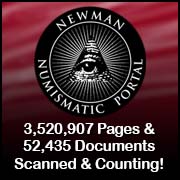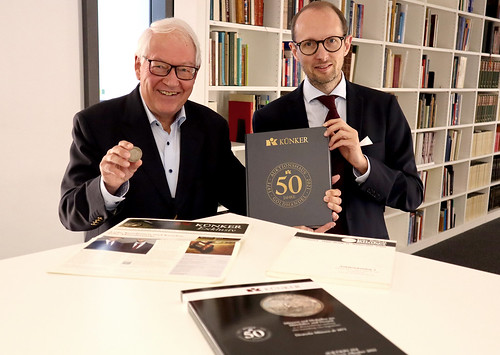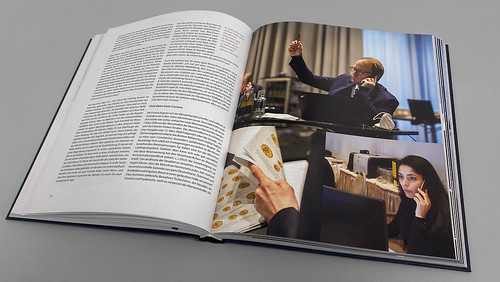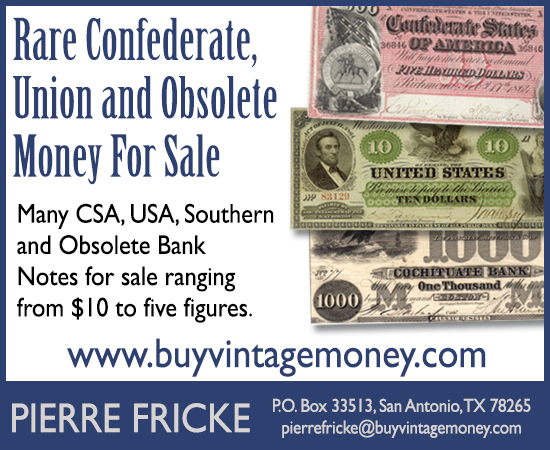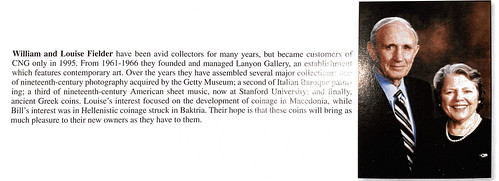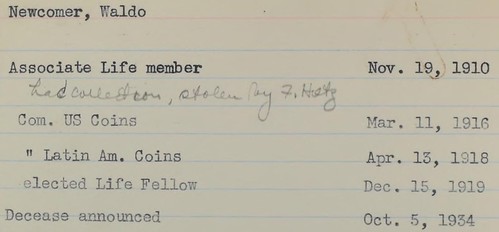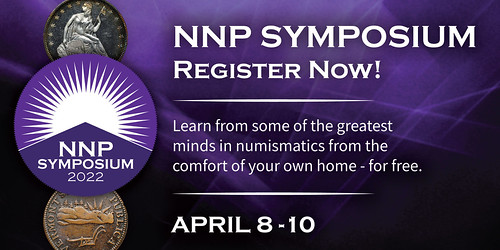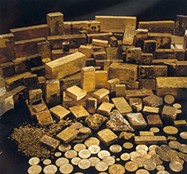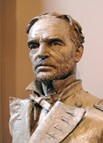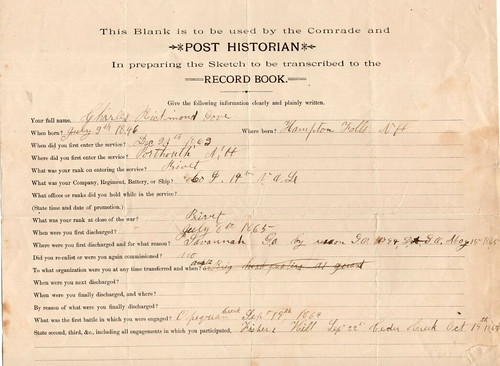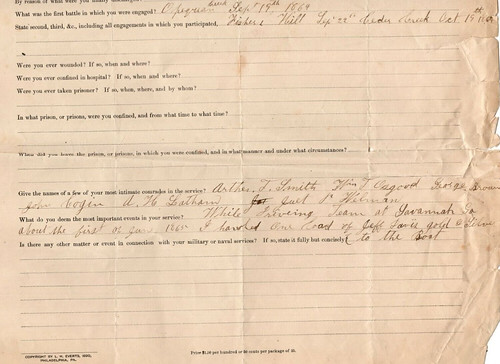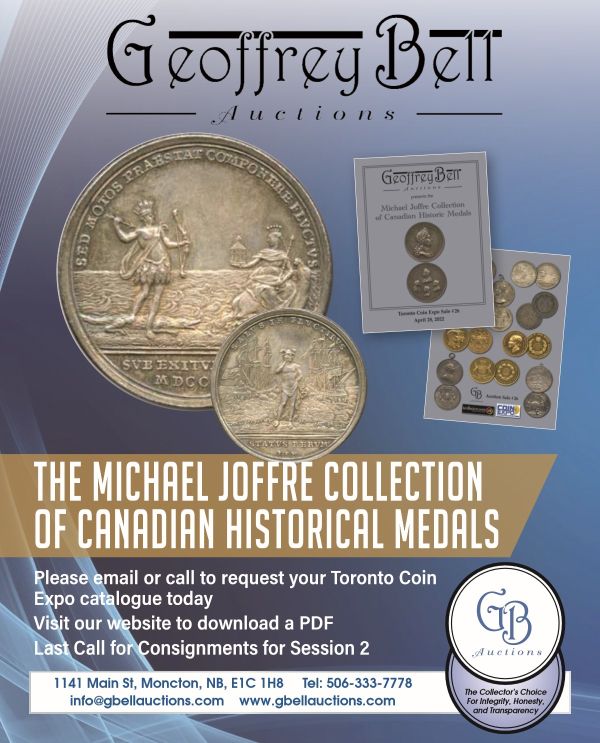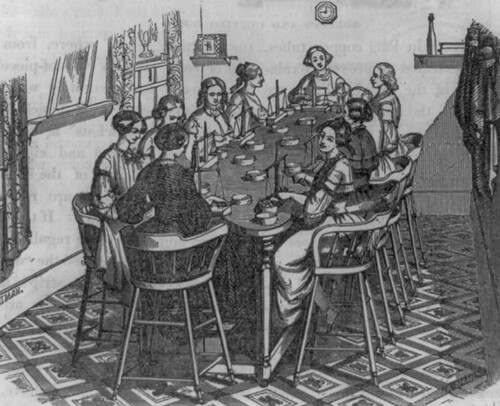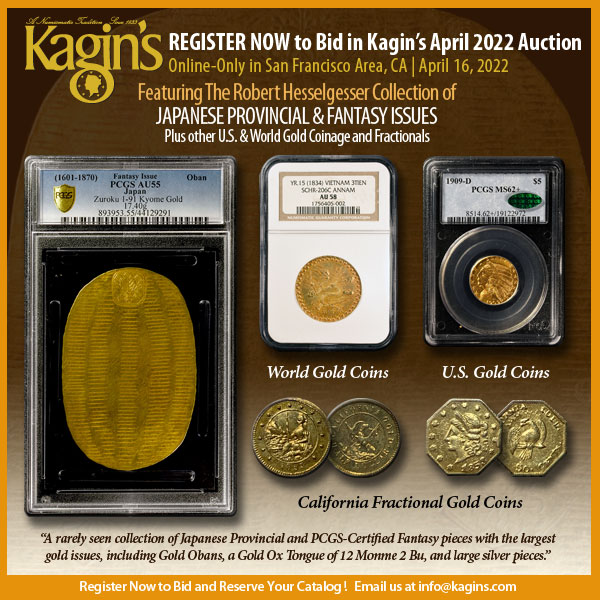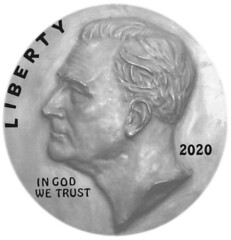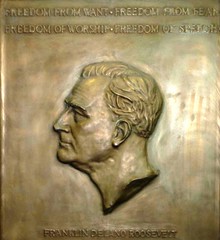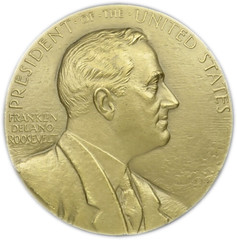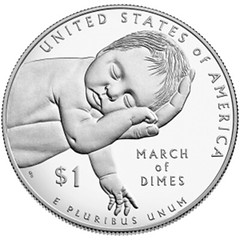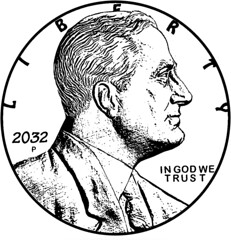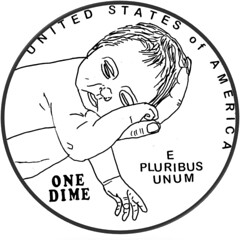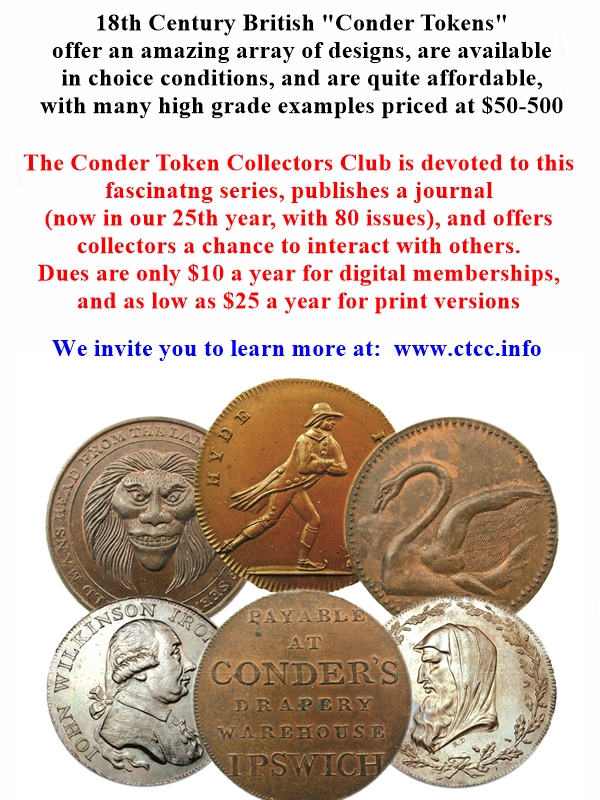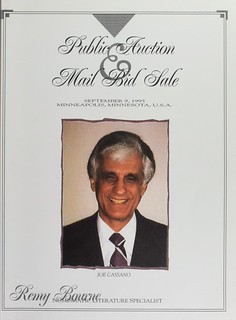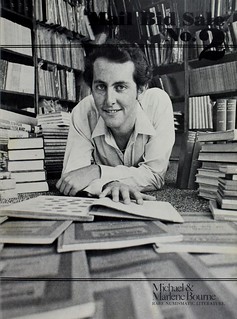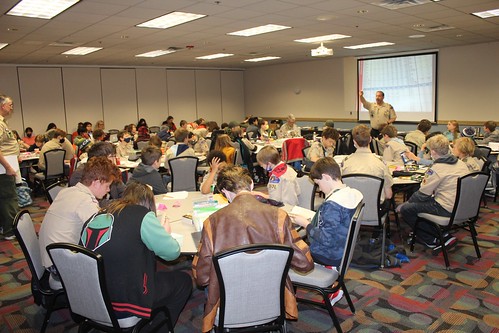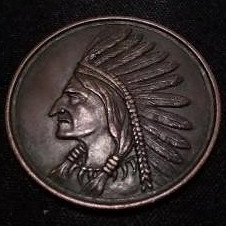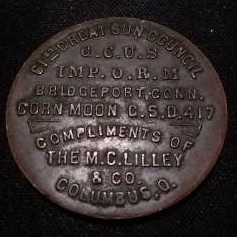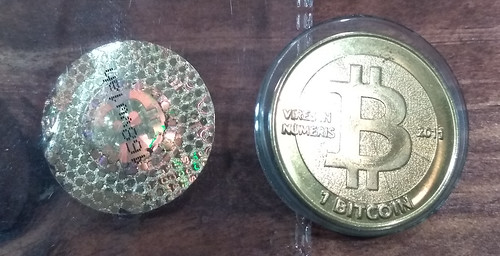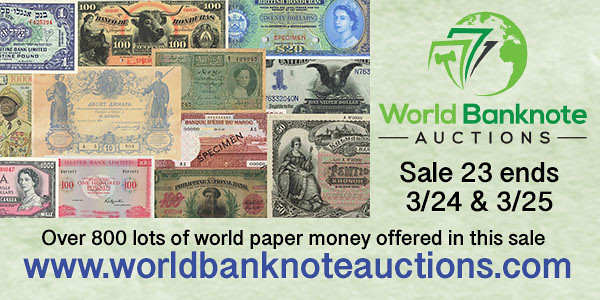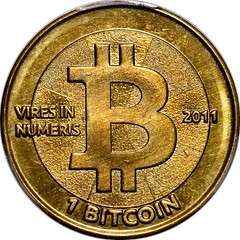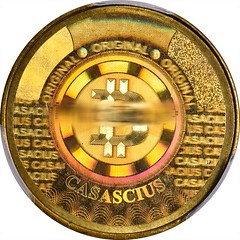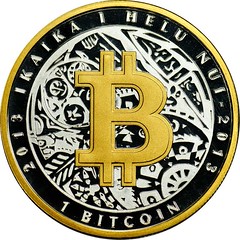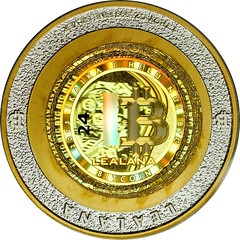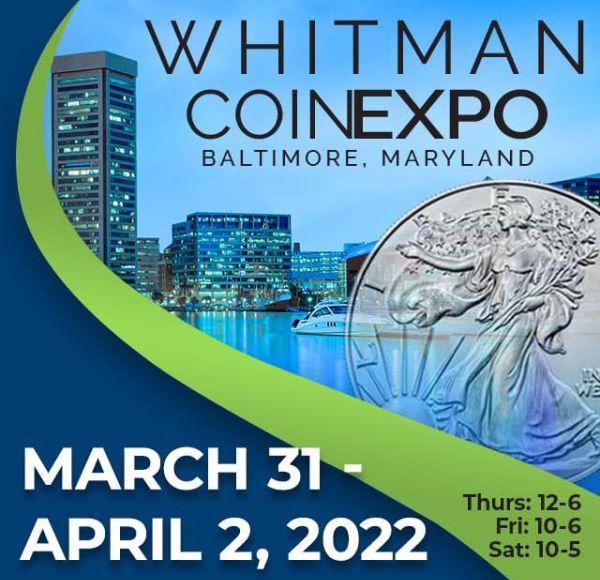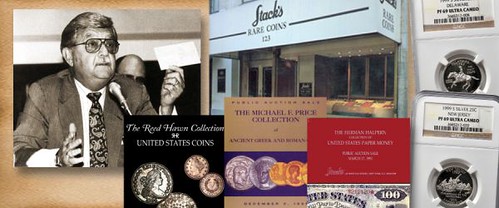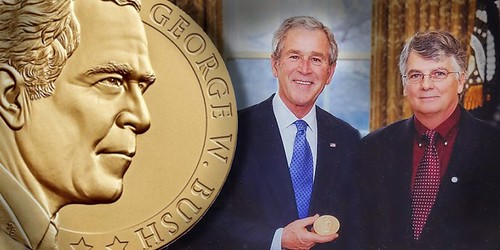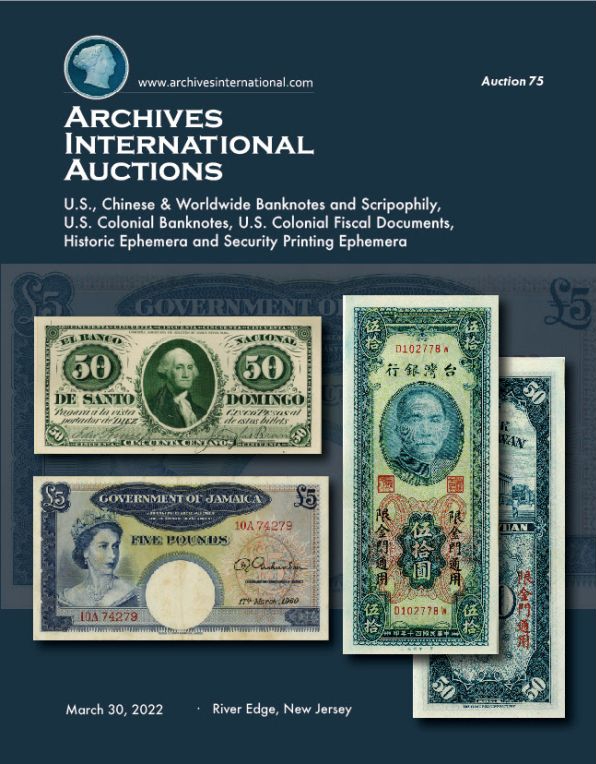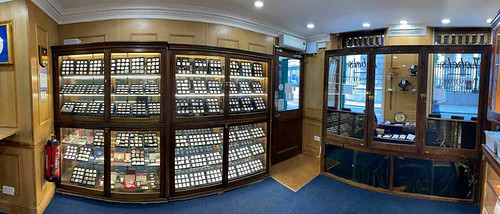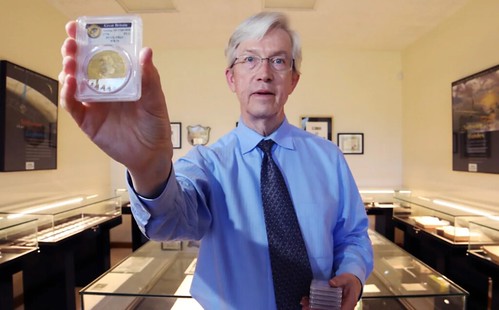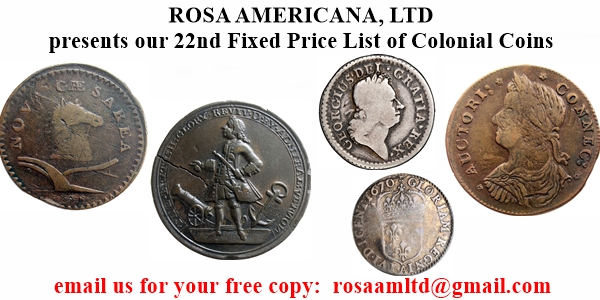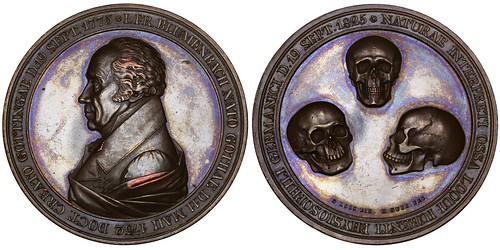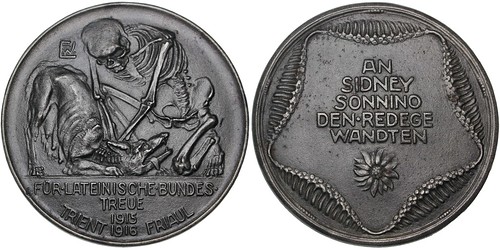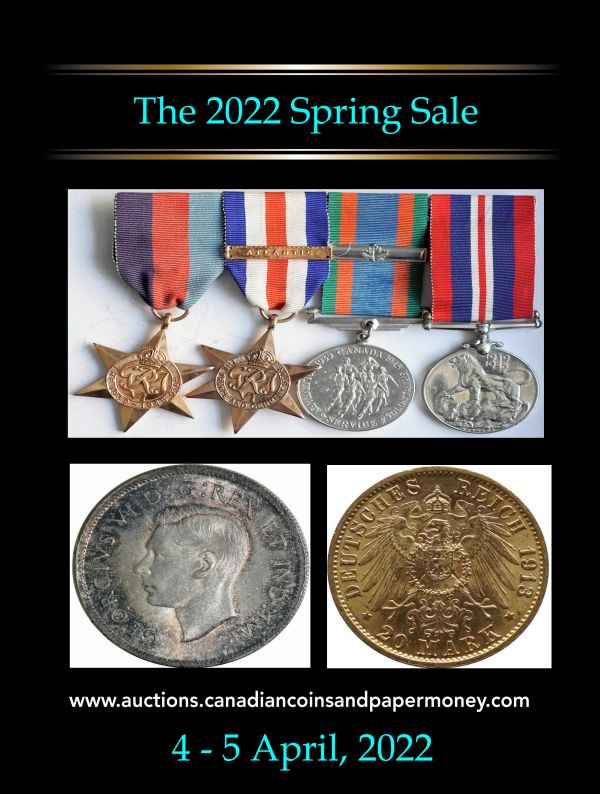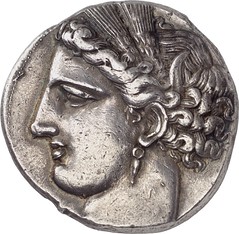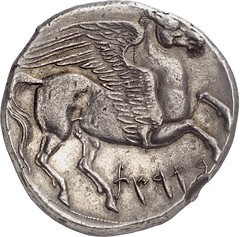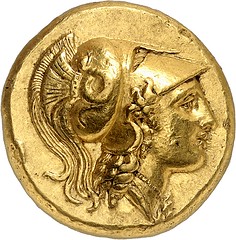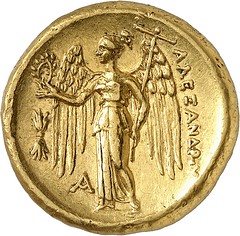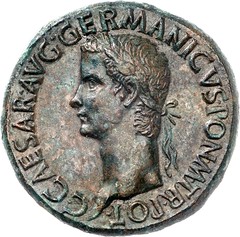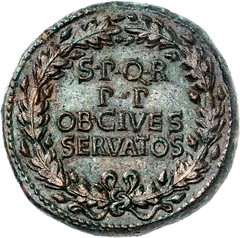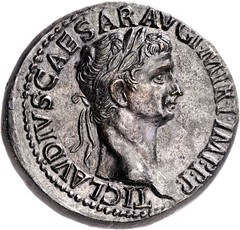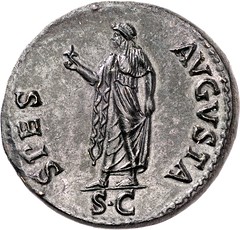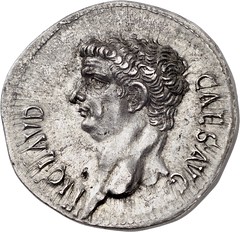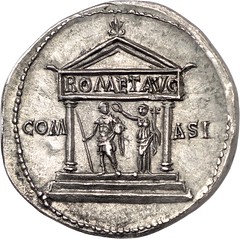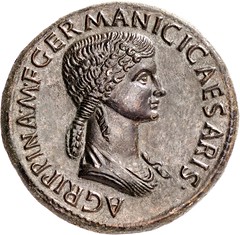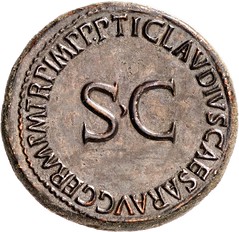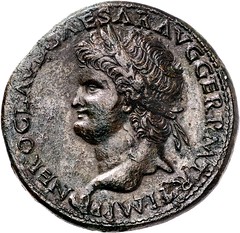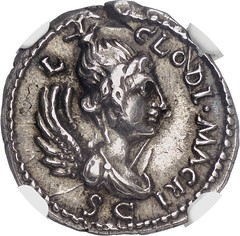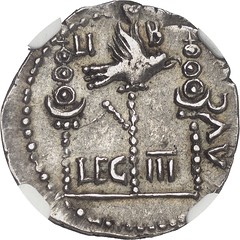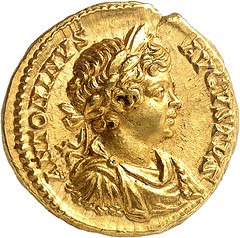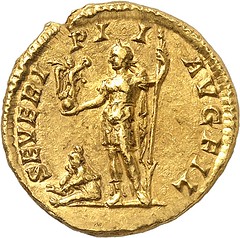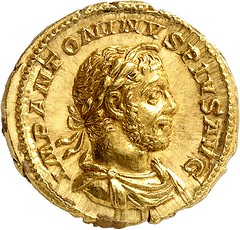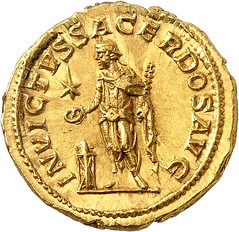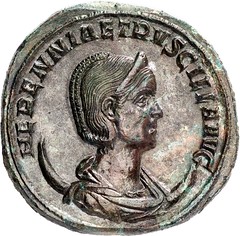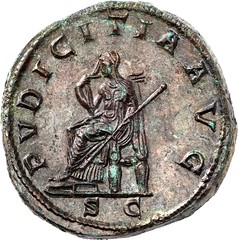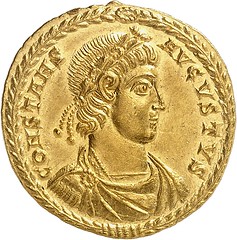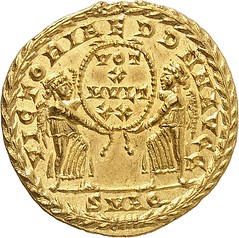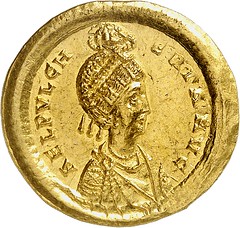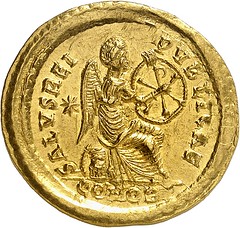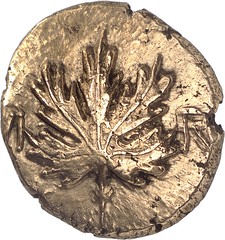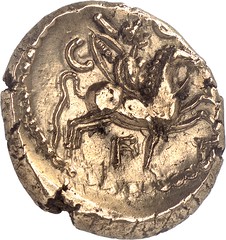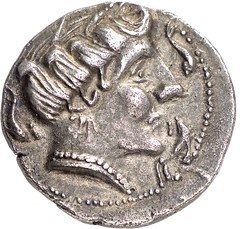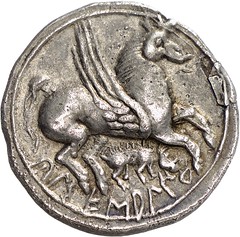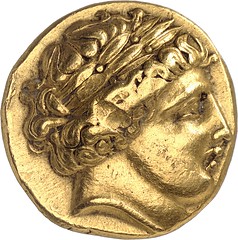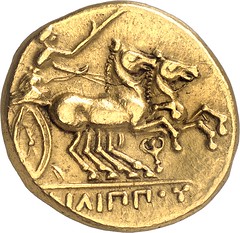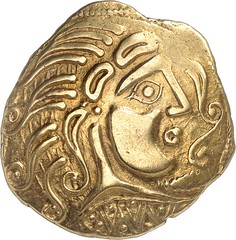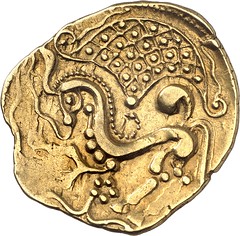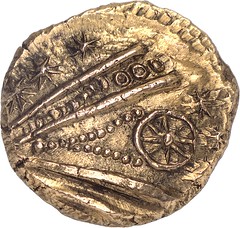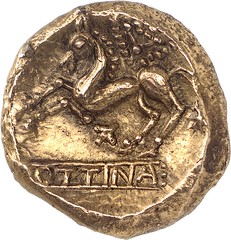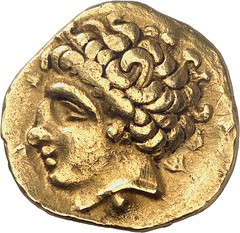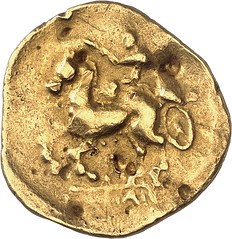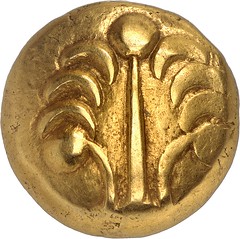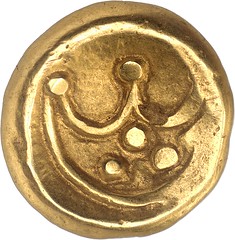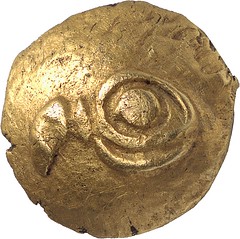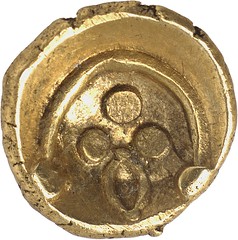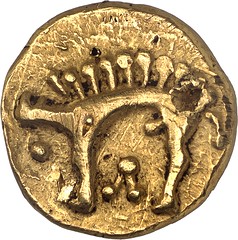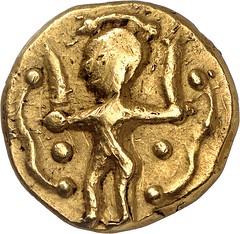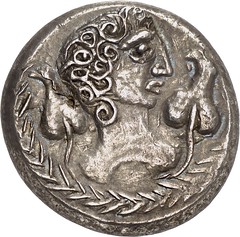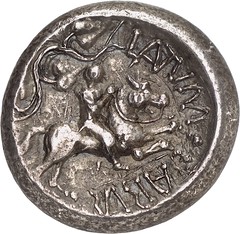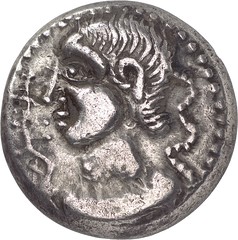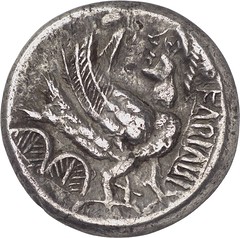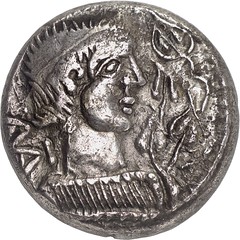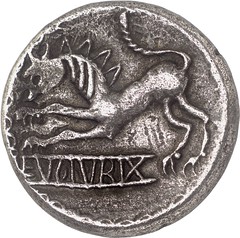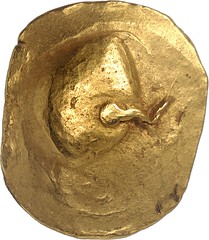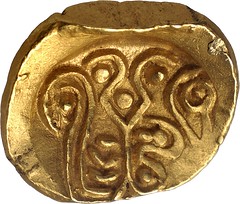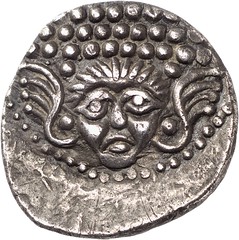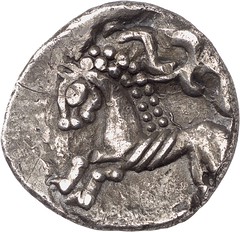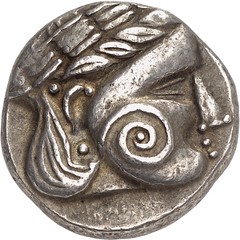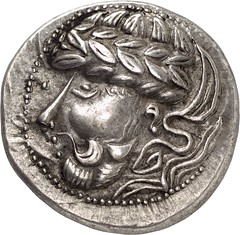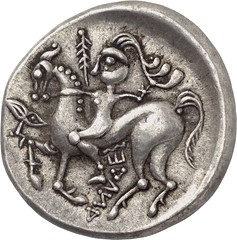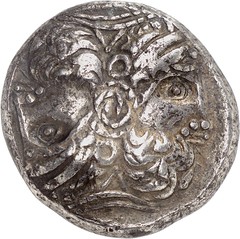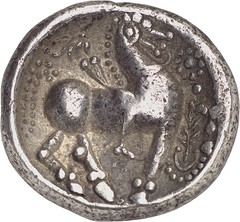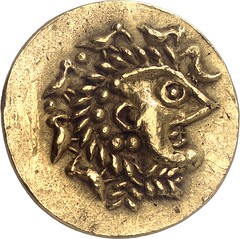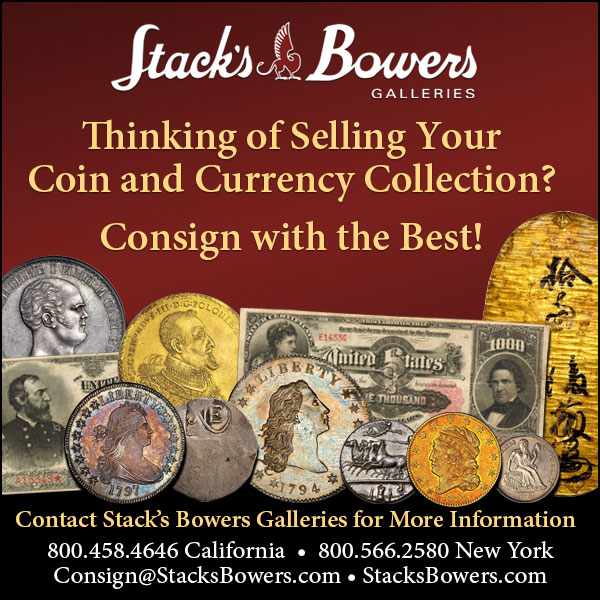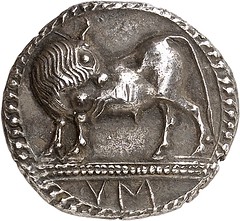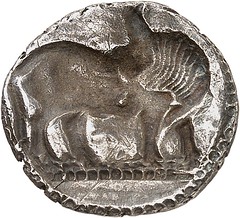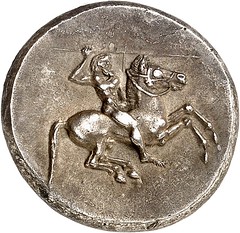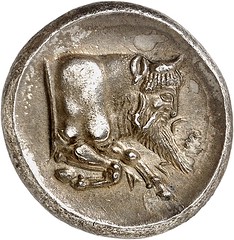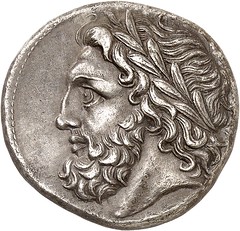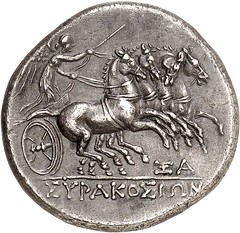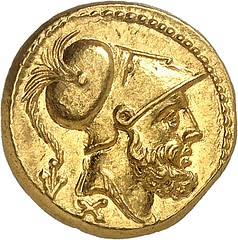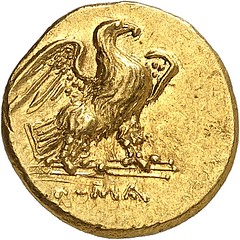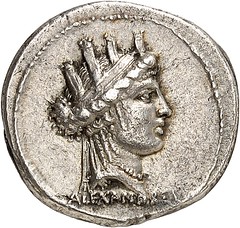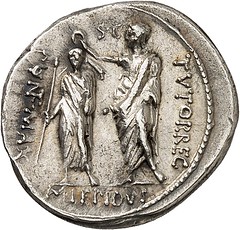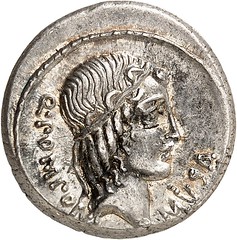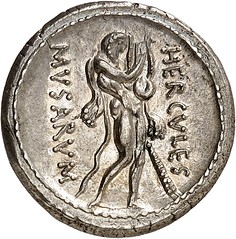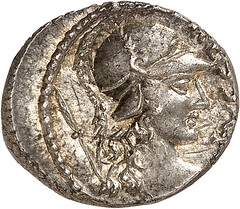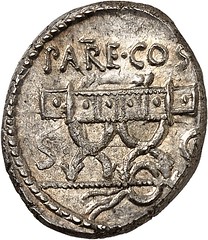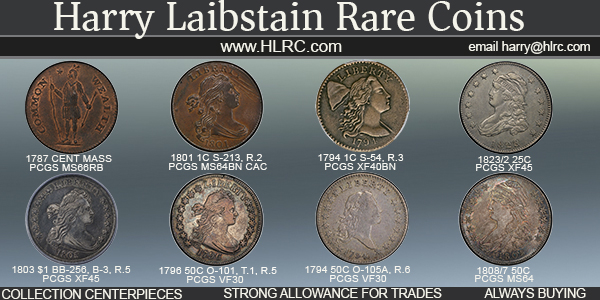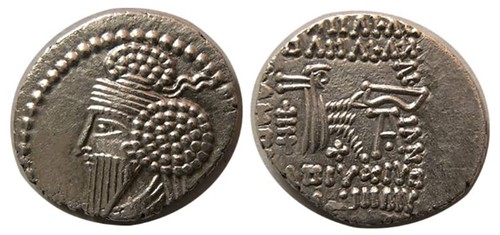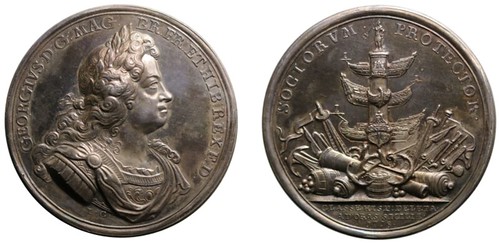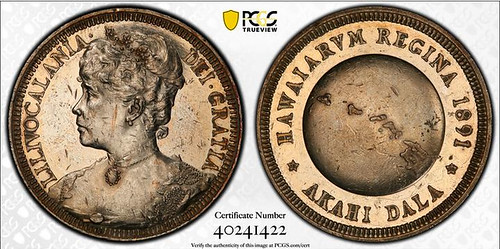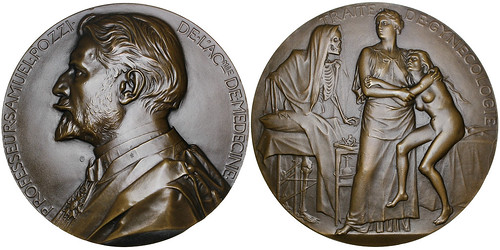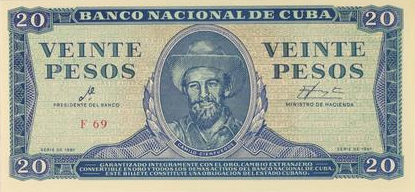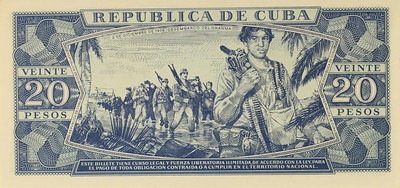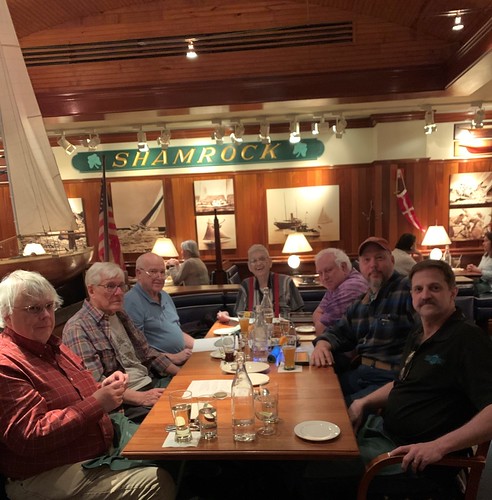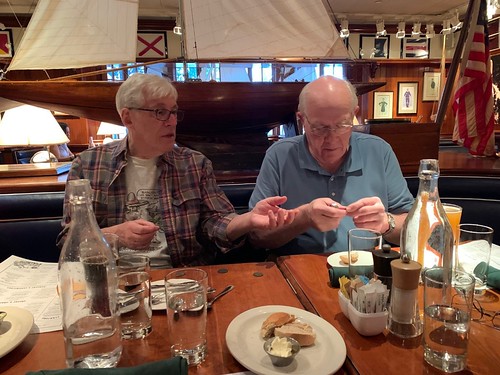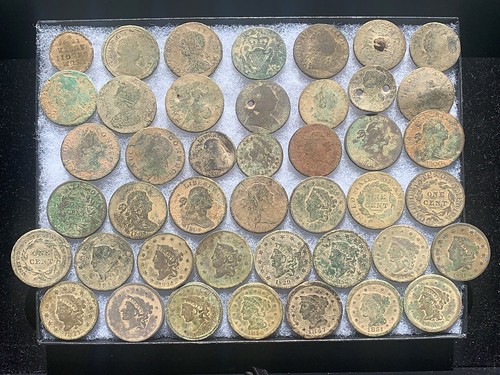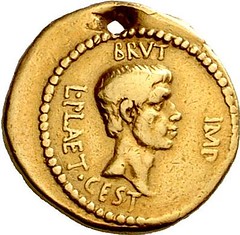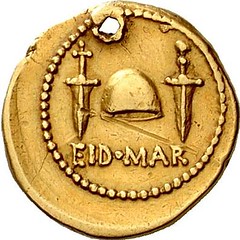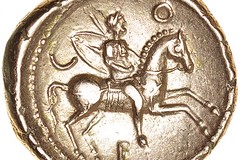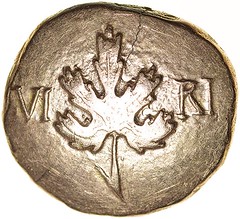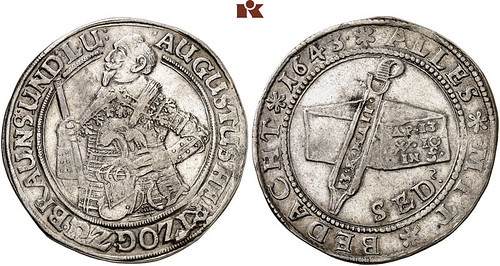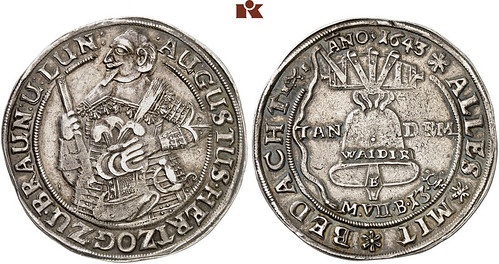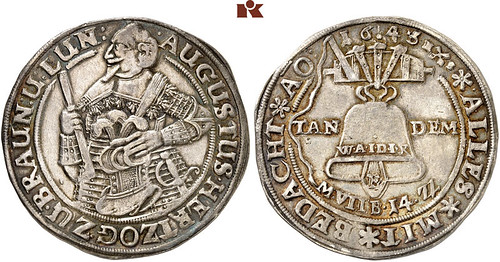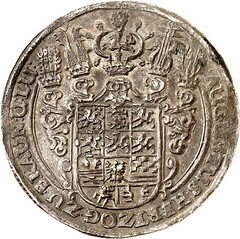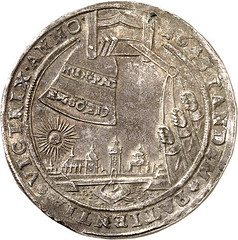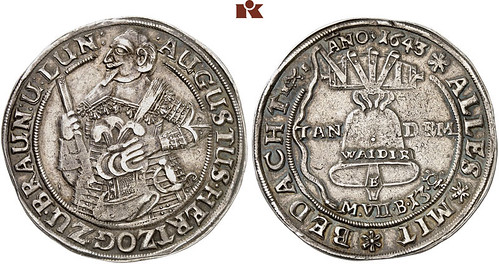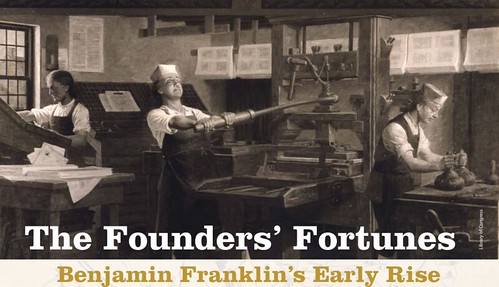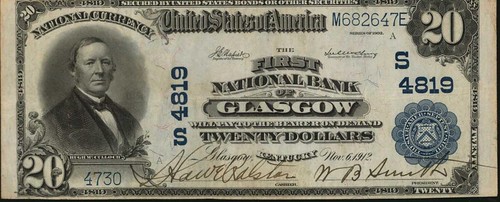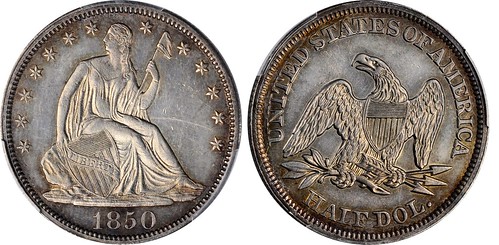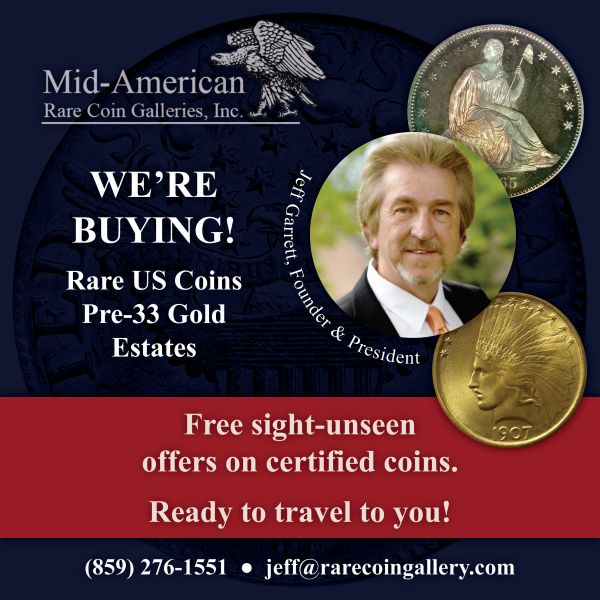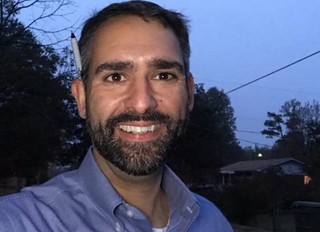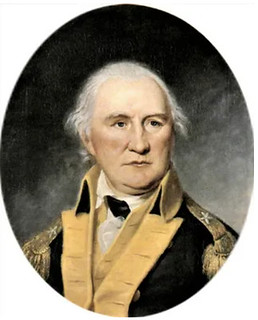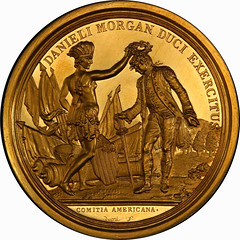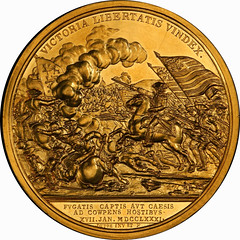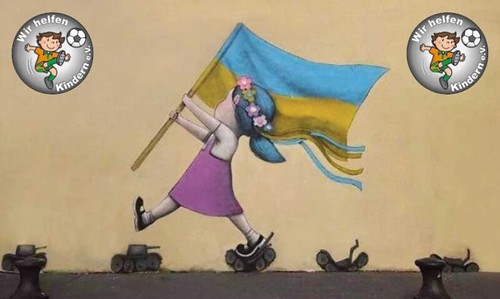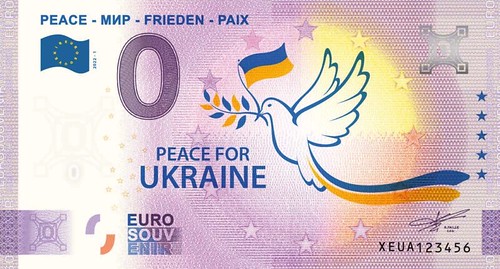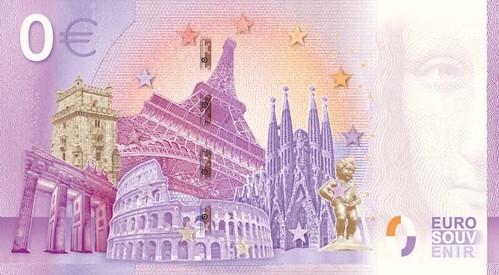
Visit our NBS Sponsors



About UsThe Numismatic Bibliomania Society is a non-profit association devoted to the study and enjoyment of numismatic literature. For more information please see our web site at coinbooks.org SubscriptionsThose wishing to become new E-Sylum subscribers (or wishing to Unsubscribe) can go to the following web page link MembershipThere is a membership application available on the web site Membership Application To join, print the application and return it with your check to the address printed on the application. Print/Digital membership is $40 to addresses in the U.S., and $60 elsewhere. A digital-only membership is available for $25. For those without web access, write to: Charles Heck, Treasurer AsylumFor Asylum mailing address changes and other membership questions, contact Chuck at this email address: treasurer@coinbooks.org SubmissionsTo submit items for publication in The E-Sylum, write to the Editor at this address: whomren@gmail.com BUY THE BOOK BEFORE THE COIN |
- WAYNE'S WORDS: THE E-SYLUM MARCH 20, 2022
- NEW BOOK: CELEBRATING 50 YEARS OF KÜNKER
- LOUISE D. FIELDER (1926-2022)
- EARLY ANS MEMBERSHIP RECORDS DIGITIZED
- NEWMAN PORTAL SYMPOSIUM APRIL 8-10, 2022
- VIDEO: 2021 USMEX COIN CONVENTION
- MAY 2022 PAN SHOW CIVIL WAR MONEY SHOWCASE
- HAULING JEFF DAVIS GOLD & SILVER
- MORE ON WOMEN AND THE U.S. MINT
- A NEW DESIGN FOR THE DIME
- NOTES FROM E-SYLUM READERS: MARCH 20, 2022
- STACK'S BOWERS SPRING 2022 PHYSICAL BITCOINS
- ANS NAMES ELKINS AS DEPUTY DIRECTOR
- VOCABULARY TERM: HUMAN FIGURE
- HARVEY STACK'S NUMISMATIC FAMILY, PART 117
- DON EVERHART'S CAREER IN COINS, PART 8
- SUBSCRIBER PROFILE: RICHARD LOBEL OF COINCRAFT
- TYRANT COLLECTION OWNER DAN O'DOWD
- NUMISMAGRAM MEDAL SELECTIONS: MARCH 2022
- KÜNKER AUCTION SALE 365: ANCIENT WORLD
- KÜNKER AUCTION SALE 366: MONEY OF THE CELTS
- KÜNKER AUCTION SALE 367: GREEK COINS
- NUMISMATIC NUGGETS: MARCH 20, 2022
- TOM KAYS' NUMISMATIC DIARY MARCH 20, 2022
- HOLED GOLD EID MAR OFFERED
- CELTIC KING VERICA STATER UNCOVERED
- BELL TALERS
- FRANKLIN'S POCKET CHANGE
- UNCLE STEVE LANDRUM'S COINS AND PAPER MONEY
- COVERAGE OF THE DANIEL MORGAN GOLD MEDAL
- ZERO EURO NOTES RAISE FUNDS FOR UKRAINE
Click here to read the thin version on the web
Click here to subscribe
Click here to access the complete archive
To comment or submit articles, reply to whomren@gmail.com
Content presented in The E-Sylum is not necessarily researched or independently fact-checked, and views expressed do not necessarily represent those of the Numismatic Bibliomania Society.
WAYNE'S WORDS: THE E-SYLUM MARCH 20, 2022
 No new subscribers this week.
We now have 6,6957 subscribers.
No new subscribers this week.
We now have 6,6957 subscribers.
Thank you for reading The E-Sylum. If you enjoy it, please send me the email addresses of friends you think may enjoy it as well and I'll send them a subscription. Contact me at whomren@gmail.com anytime regarding your subscription, or questions, comments or suggestions about our content.
This week we open with one new book, an obituary, updates from the Newman Numismatic Portal, the Civil War Money Showcase, and more.
Other topics this week include ANS members, women at the U.S. Mint, physical bitcoins, Don Everhart, Richard Lobel, the unmasked Tyrant Collection owner, auction previews, clickbait coin headlines, Eid Mar, and zero Euro notes for Ukraine fundraising.
To learn more about Louise Fielder, the NNP Symposium, the SS Central America and General William T. Sherman, loading "Jeff Davis gold & silver to the boat", designs for the dime, Remy and Michael Bourne, the Improved Order of Red Men, Bitcoin seller's remorse, the gold coin collection of Richard and Jean Salisbury, the numismatic gynecologist, wine-swilling kings, bell talers, Ben Franklin's pocket change, Kentucky's "Uncle" Steve Landrum, phrenology, craniometry and respectable ladies of reduced means, read on. Have a great week, everyone!
Wayne Homren
Editor, The E-Sylum
NEW BOOK: CELEBRATING 50 YEARS OF KÜNKER
A new book documents the fifty-year history of the German coin firm KÜNKER. -Editor
Celebrating 50 Years of KÜNKER – The Book
In 2021 KÜNKER celebrated its 50th anniversary. To mark the occasion, the auction house commissioned a company chronicle, which reflects the history of the German coin trade since 1971. It's the centerpiece of a heavyweight commemorative publication.
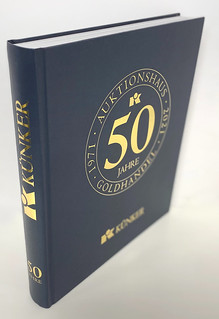 On 1 July 1971, Fritz Rudolf KÜNKER founded his coin dealership in Schapdetten, Westphalia (Germany). He was one of many young men who ventured to take this step at the time. By now, the small company has developed into the internationally renowned Osnabrück auction house KÜNKER, trusted by collectors all over the world.
On 1 July 1971, Fritz Rudolf KÜNKER founded his coin dealership in Schapdetten, Westphalia (Germany). He was one of many young men who ventured to take this step at the time. By now, the small company has developed into the internationally renowned Osnabrück auction house KÜNKER, trusted by collectors all over the world.
A great reason to celebrate! Unfortunately, it soon became clear that it would be impossible to organize a big party for customers and business partners due to the current situation. But the management didn't want to let this anniversary pass by unnoticed either. Thus, the idea was born to have a company chronicle written on the occasion of the 50th anniversary that was to tell the auction house's own story and – what's more – place it in the context of the coin trade as a whole.
This exciting task was taken on by Dr Ursula Kampmann – historian and one of the world's best-known numismatic journalists, and someone who has had a close connection to KÜNKER for many years. She proceeded according to a somewhat modified method of oral history. Since the fall of 2020, she conducted 41 interviews – most of them lasting several hours – in order to reconstruct the history of KÜNKER as well as the daily stories of a typical German coin dealership based on the statements made by the interviewees.
The result is an opulent work entitled Celebrating 50 Years of KÜNKER
. In an entertaining and knowledgeable way, the easy-to-read book explains how the numismatic market has changed due to political shifts and technological innovations, and how KÜNKER reacted to all these challenges. Anyone who's wondering why KÜNKER occupies such a major position in the numismatic world today will find their answer in this book. And they will also learn how auction catalogs were created and auctions conducted in the 1980s, without the help of any computers. It goes without saying that there is enough room for brief, endearing anecdotes too.
Of course, numismatics plays a key role in the book: the renowned numismatist and historian Prof Dr Johannes Nollé contributed a chapter on KÜNKER and Numismatic Scholarship
and also wrote the section Magical Moments for Collectors – Highlights from our Auctions from the early days until today
containing 22 texts on historically interesting treasures auctioned off by KÜNKER.
Celebrating 50 Years of KÜNKER
is more than a company chronicle, it's an important contribution to the history of the modern coin trade, reviving the past of all coin collectors and dealers.
The large-format illustrated book, lavishly designed by Helge Lewandowsky, can be purchased at KÜNKER for 35 euros plus postage and shipping charges. The English version will be published in February 2022 and can be purchased for the same price.
To promote and foster a close cooperation of scholars, museums and coin dealers, is very important to auction house KÜNKER. Therefore, all numismatic collections and scholarly institutes will receive a free copy upon request – subject to availability.
Send your order via email to service@kuenker.de or order directly at https://www.kuenker.de/en/shop.
LOUISE D. FIELDER (1926-2022)
American Numismatic Society member Louise Fielder has passed. The William and Louise Fielder collection included early royal Macedonian and Baktrian coins as well as tribal issues from the Thraco Macedonian region (Coin World, November 1, 2004). -Editor
Louise Fielder
December 29, 1926 - March 11, 2022
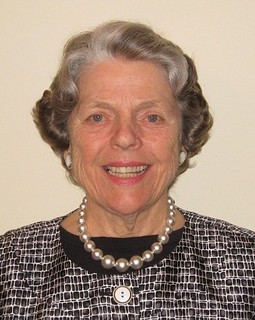 Louise Dunn Fielder, a fifth-generation Californian, passed away on March 11 in Palo Alto. Her family arrived in Suisun, CA on a 80-wagon train from Missouri in 1850, and then settled in Vacaville, CA. Louise was born in San Francisco in 1926, a third-generation San Franciscan. She completed her primary education in San Francisco before attending the University of Colorado. Two days after her university graduation in 1949, Louise married William Ridge Fielder, who was attending medical school at the University of Colorado in Denver. Two children were born in Denver - Louis Dunn Fielder and Kathleen Louise Fielder. A third child, William Ridge Fielder Jr., was born at Stanford Hospital in San Francisco.
Louise Dunn Fielder, a fifth-generation Californian, passed away on March 11 in Palo Alto. Her family arrived in Suisun, CA on a 80-wagon train from Missouri in 1850, and then settled in Vacaville, CA. Louise was born in San Francisco in 1926, a third-generation San Franciscan. She completed her primary education in San Francisco before attending the University of Colorado. Two days after her university graduation in 1949, Louise married William Ridge Fielder, who was attending medical school at the University of Colorado in Denver. Two children were born in Denver - Louis Dunn Fielder and Kathleen Louise Fielder. A third child, William Ridge Fielder Jr., was born at Stanford Hospital in San Francisco.
The family spent one year in London, England, while her husband trained at St. Bartholomew's Hospital, 1956 - 1957. They relocated to the Peninsula when Stanford Hospital moved to Palo Alto in 1958.
In 1961 the Fielders established the Lanyon Gallery in the Old Stanford Barn. It became a showcase for European and Contemporary California Art and was managed by Louise until it closed in 1966.
Louise served for 6 years as a trustee of the California Historical Society in San Francisco, and was chair of the Society's Library Committee for many years. During these years, she researched and wrote an unpublished manuscript of 19th century California photographically-illustrated books. Louise also served as a board member of the Committee For Art at Stanford for many years, and organized and managed the Art Department Stanford Treasure Market for 8 years.
Louise was a founding member of the Society for the Encouragement of Contemporary Art at the San Francisco Museum of Modern Art, and was involved at the museum for many years. She was actively interested in art, photography, and rare books, and traveled widely throughout the world with her husband. In later years, they became collectors of ancient Greek coins and were members of the Royal Numismatic Society in London, and American Numismatic Society in New York.
William and Louise celebrated 56 years of marriage until William passed away in 2005. A private burial will be held for Louise at Skylawn Memorial Park in San Mateo County. She will be buried next to her husband, as loving parents and grandparents.
Victor England of Classical Numismatic Group, LLC. writes:
"I remember Bill and Louise fondly. They were active members of SFANS (San Francisco Ancient Numismatic Society) and regularly attended meetings and shows. Both had an avid interest in coins.
"In Triton VIII we ran an obituary for Bill."
Victor passed along this bio of the couple from the CNG catalog of their collection. Thank you. -Editor
To read the complete article, see:
Louise Fielder
(https://www.legacy.com/us/obituaries/sfgate/name/louise-fielder-obituary?id=33682864)
THE BOOK BAZARRE
EARLY ANS MEMBERSHIP RECORDS DIGITIZED
The latest additions to the Newman Numismatic Portal are early membership cards for the American Numismatic Society. Project Coordinator Len Augsburger provided the following report. -Editor
Early ANS Membership Records Digitized Under NNP Sponsorship
Among the American Numismatic Society archives are a group of 1,700 file cards detailing early ANS members and their related activities at ANS. The group covers from inception (1858) to the mid-1940s. Occasional tidbits are present, such as this note on the card for Baltimore collector Waldo Newcomer, had collection, stolen by F. Hotz.
Particularly active members have multiple cards, with the record for Edward T. Newell extending to six cards and noting ANS roles from Active Member
(1905) to President
(1918-1941). As a biographical aid, many of the records include member death dates.
ANS Librarian David Hill notes that the management history of this file is not completely clear. Cards were clearly created retroactively in some cases. Additionally, some early members have been identified who do not have cards. Still, numismatic biographers will find this a useful resource.
Image: American Numismatic Society membership card for Waldo Newcomer
Link to Early ANS Membership Cards:
https://archive.org/details/ansmembershipcar00amer/mode/1up
NEWMAN PORTAL SYMPOSIUM APRIL 8-10, 2022
Newman Numismatic Portal Project Coordinator Len Augsburger also passed along this reminder to register for the upcoming NNP Symposium. -Editor
Newman Portal Symposium Returns April 8-10
The Newman Portal Symposium, an online numismatic event held via Zoom, returns April 8-10. There are 25 speakers committed so far, who will present on a variety of topics related to ancient and modern numismatics. Free registration is required to attend this event. Our feature presentation will be a behind-the-scenes look at the Dell Loy Hansen collection, including a new video by Lianna Spurrier that will premier during the Symposium. We'll also have a presentation from Mike Garofalo, author of the recently published Secrets of the Rare Coin & Bullion Business. CDN has graciously agreed to furnish up to 60 free copies of this book for attendees – tune in to this presentation for details!
Link to Newman Portal Symposium registration:
https://nnpsymposium.org/register
To read the earlier E-Sylum article, see:
FOURTH NNP SYMPOSIUM ANNOUNCED
(https://www.coinbooks.org/v25/esylum_v25n09a11.html)
VIDEO: 2021 USMEX COIN CONVENTION
These are selections from the David Lisot Video Library that feature news and personalities from the world of coin collecting. David has been attending coin conventions since 1972 and began videotaping in 1985. The Newman Numismatic Portal now lists all David's videos on their website at:
https://nnp.wustl.edu/library/multimediadetail/522852
Here's one on the 2021 USMEX Coin Convention. -Editor
Cool Mexican Coins at USMEX Coin Convention 2021.
VIDEO: 13:46.
David Lisot, Interviewer, CoinTelevision.com with Ali & Cory Frampton,
Larry Stendebach, and Pat Stovall. October 21-23, 2021
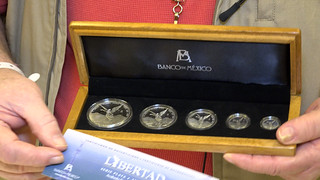 David Lisot takes you to the floor of the annual US Mexican Numismatic Association Convention where you will see Mexican Hookneck 8 reales, Silver Libertads, and banknotes of Pancho Villa.
David Lisot takes you to the floor of the annual US Mexican Numismatic Association Convention where you will see Mexican Hookneck 8 reales, Silver Libertads, and banknotes of Pancho Villa.
David adds:
"The annual US Mexican Numismatic Association Convention is a small convention of about 25 dealers specializing in Mexican and Latin coinage. Some interesting coins surface at this show. I had the pleasure of interviewing some of the dealers who shared their cool items."
An excerpt of the video is available for viewing on the Coin Television YouTube Channel at:
https://youtu.be/Rp22h5y4Plg
MAY 2022 PAN SHOW CIVIL WAR MONEY SHOWCASE
Rick Lank and Rebecca Rush submitted this announcement of their first Civil War Money & Memorabilia Showcase event at the upcoming spring Pennsylvania Association of Numismatists show. -Editor
The Inaugural Civil War Money & Memorabilia Showcase event will be hosted at the PAN Coin Show in Monroeville, Pennsylvania from May 19th through 21st. The CW Showcase will feature exhibits, displays and talks -- each featuring collectible items from the era – including coins, paper currency, scrip, tokens, and more.
A special theme will involve the unexpected connection between the tragic sinking of the doomed SS Central America and the life of General William T. Sherman before the Civil War broke out. In the mid-1850s, Sherman was in San Francisco – a rising star in banking during the Gold Rush era,
said Rick Lank, author and organizer. His banking concern, Lucas & Co., dealt with the prominent assayers who provided banks and the federal government with gold ingots.
Gold was shipped east via Panama on paddle-wheelers such as the SS Central America.
Among the speakers being lined up for the Showcase, a featured guest will be Bob Evans – who has been the chief researcher and curator for the SS Central America and its enormous Garden of Gold
that was found 8,000 feet under the Atlantic in the late 1980s – the treasure included over 2 tons of gold ingots and San Francisco minted gold coins that were lost at sea in 1857. This loss – estimated at $50 million in today's dollars -- had a tremendous impact on the nation's economy, as it was intended to be a special reserve to stabilize an already rocky banking community. That maritime disaster set off the Panic of ‘57
and indirectly caused the collapse of several banks – causing Uncle Billy the Banker
to lose his second banking job and sank his career in finance. Subsequent events then catapulted Sherman to New Orleans, just in time for Louisiana to secede and jettison Uncle Billy
Sherman into the War... and the history books.
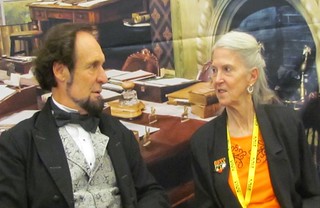 According to Rebecca Rush (pictured with Abe Lincoln interpreter Dennis Boggs at the October 2021 PAN show) there will be talks about
According to Rebecca Rush (pictured with Abe Lincoln interpreter Dennis Boggs at the October 2021 PAN show) there will be talks about The Treasury Girls of 1862
and roles played by hometown women who raised massive amounts of money through Sanitary Fairs. President Abe Lincoln played many roles in financing the Civil War, including authorizing the printing of our first Greenbacks
and three new mints at the height of the War. We will also follow the money
in the saga about the Confederate Treasure Train as it trundled from Richmond, Virginia to Georgia in April and May of 1865– dispensing gold, silver, CSA paper money, and bonds along its route. (General Joe Johnston, who surrendered to General Sherman, in North Carolina, converted many silver pesos into CSA mementoes as part of his last payroll.)
An invitation to participate in the Showcase has been extended to the National Civil War Museum in Harrisburg, PA.
The organizers represent a 501-c-3 non-profit offering programs about Money Matters of the Civil War called No Small Change.
Contributions to the educational mission of the non-profit are welcome. Sponsors for the CW Showcase event are also being sought and sponsors will be recognized on promotional materials.
More details about the activities and participants will be forthcoming.
Contact No Small Change
at
cwshowcase@no-small-change.org
HAULING JEFF DAVIS GOLD & SILVER
Chelius H. Carter of Fredericksburg, VA submitted this curious document possibly relating to the disposition of the Confederate government Treasury at the end of the Civil War. Thank you! -Editor
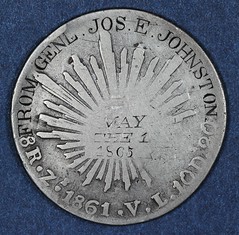 We corresponded (06 September 2020) shortly after I had purchased a silver Mexican 8 Real coin documented as being one of C.S. Gen. Joseph E. Johnston's final payrolls to the Confederate Army of Tennessee, following their surrender at Greensboro, North Carolina in May of 1865.
We corresponded (06 September 2020) shortly after I had purchased a silver Mexican 8 Real coin documented as being one of C.S. Gen. Joseph E. Johnston's final payrolls to the Confederate Army of Tennessee, following their surrender at Greensboro, North Carolina in May of 1865.
I was intrigued to follow the myriad paths of the much-debated "lost Confederate treasury"...as I had one piece of specie from that original cache. I was later able to track down the soldier's original Parole Pass issued at Charlotte, NC and MUCH later...a photograph of the man showed up on Find A Grave - posted by a descendant.
Mind you...I'm no "conspiracy theorist" as to the lost Confederate treasury...don't really follow its many stories...BUT...I recently ran across another twist that takes the Confederate treasury (or at least part of it) in another direction. While I was not able to win this document, recently on eBay...I did save the scan which in the excerpt (below) clearly states that the soldier,
"While driveing Team at Savannah Ga about the first of June 1865 I hauled One load of Jeff Davis gold & silver to the boat."
This is from a post-war questionnaire for a Confederate veterans' group; this man's account is something different than what I've read about it being hauled into the South's interior.
My thinking is that the soldier writing this many years after the War...might have mis-remembered the month, but he surely did not mis-remember the unusual task they had to do.
It strongly reminds of the beginning scene in SAHARA - a Clive Cussler adventure novel that became a movie starring Matthew McConaughey... a great scene with an entirely improbable story that followed - but wholly entertaining.
To watch the opening of Sahara, see:
War Scene 6# - Sahara - Ironclad - Intro
(https://www.youtube.com/watch?v=rlJFd162Z7s)
Chelius sent along images of the complete document. Is it real? An eBay concoction? Interesting regardless. -Editor
To read earlier E-Sylum articles, see:
CONFEDERATE TREASURY MEXICAN COIN
(https://www.coinbooks.org/v23/esylum_v23n36a13.html)
CIVIL WAR GOLD TALES IN THE NEWS
(https://www.coinbooks.org/v21/esylum_v21n11a26.html)
MORE TELEVISION AND MOVIE NUMISMATICS
(https://www.coinbooks.org/v25/esylum_v25n09a15.html)
MORE ON WOMEN AND THE U.S. MINT
Jerome Nashorn submitted this piece with more background on the early women of the U.S. Mint. Thank you! -Editor
More on women and the Mint in the late 19th Century
It was interesting to read about female U.S. Mint adjusters having to resign when they got married. However, this is not surprising given that the so-called marriage bar for women was common, in both public and private employment, until several decades into the 20th century.
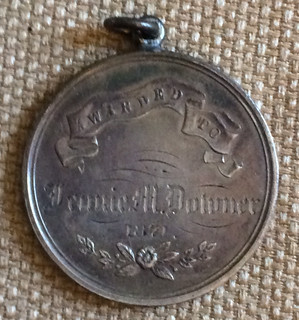 I got interested in the Mint adjusters several years ago when researching an academic award medal I'd purchased. The medal was awarded by the Denman Grammar School, a school for girls in San Francisco to Jennie Downer in 1871. Through San Francisco city directories (available on archive.org), the 1880 Census, and the early 1880s editions of the Official Register of United States, which listed all U.S. government employees, I found that Jennie Downer, who was born about 1858, was employed in the San Francisco Mint adjusting room from 1879 to 1885. She and about 25 other Mint employees were let go in the fall of 1885 soon after Grover Cleveland assumed the presidency, an event that was reported in the local papers (see Daily Alta California, October 1, 1885, available online at the California Digital Newspaper Collection, www.cdnc.edu.edu).
I got interested in the Mint adjusters several years ago when researching an academic award medal I'd purchased. The medal was awarded by the Denman Grammar School, a school for girls in San Francisco to Jennie Downer in 1871. Through San Francisco city directories (available on archive.org), the 1880 Census, and the early 1880s editions of the Official Register of United States, which listed all U.S. government employees, I found that Jennie Downer, who was born about 1858, was employed in the San Francisco Mint adjusting room from 1879 to 1885. She and about 25 other Mint employees were let go in the fall of 1885 soon after Grover Cleveland assumed the presidency, an event that was reported in the local papers (see Daily Alta California, October 1, 1885, available online at the California Digital Newspaper Collection, www.cdnc.edu.edu).
The dismissals were explained as an economy move but may have also been motivated by the new administration's desire to purge employees who'd been appointed during prior Republican administrations. After leaving the Mint, Downer, who never married, remained in San Francisco and worked as a stenographer. She died there in 1916. According to her obituary, she came from a "pioneer San Francisco family" and had been a "leader" in the charitable activities of Grace Episcopal Cathedral on Nob Hill (see Daily Call, September 4, 1916, also available on the California Digital Newspaper Collection website).
The lot of the early Mint adjusters, who were overwhelmingly women in the 19th century, was clearly not easy. In addition to being subject to the marriage bar and the vicissitudes of the spoils system, they worked under unpleasant conditions, primarily because the adjusting rooms purposely were not provided with adequate ventilation in order to ensure the accuracy of the scales and probably to prevent any grains of precious metal from escaping. This state of affairs was summed up in a letter sent to Abraham Lincoln in 1861 by a Philadelphia physician, which Len Augsburger posted to the June 30, 2019, issue of The E-Sylum.
The doctor's letter referred to the adjusters as "respectable ladies of reduced means." This description certainly fits Jennie Downer. Her father, Abner J. Downer, is described in directories issued in the 1860s as a merchant or stock broker, with an office in the San Francisco Merchant's Exchange. However, in the 1871 Directory, there is a an entry for an A.J. Downer, who is listed as a clerk. Presumably after his death in 1872 or perhaps soon before, his wife and Jennie, his only child, found themselves in reduced circumstances forcing Jennie to seek employment when she reached adulthood.
Downer's job at the Mint paid well given the other options that would have been available to her. Jennie and her fellow adjusters, all women, were paid $2.75 per day. According to a Treasury Department Bureau of Statistics Report to Congress on Internal Commerce, submitted at the end of 1890 (available on Google Books, see p. 384), female saleswomen in California received on average only $5 per week while women in many occupations in manufacturing received considerably less (female employees at a San Francisco silk factory were paid between $3 and $5.25 per week, for example, see p. 395).
Of course, just as in the private sector, the adjusters were paid less than almost all male San Francisco Mint employees who also did jobs that required minimal skills or training. For example, in 1883, janitors received $3 per day as did the messengers while workmen were paid $4 a day; only some of the watchmen were paid less than the adjusters, with most getting $2.50 a day. Men filled all of the relatively few clerical positions the Mint had to offer and were paid about $4 a day. And all the managerial jobs as well as those of a technical nature were filled by men. All the women employed at the Mint in 1883 were listed as adjusters except for the adjusting room janitor, a woman who was paid $2.25 a day, 75 cents less than the other janitors, who were all men. Since the coiners (also women) are not broken out as a separate occupation, I suspect they were lumped in with the adjusters. This data is from the Official Register of the United States for 1883 (available online at the Hathi Trust, see pp. 159ff).
The same pattern can be seen in the other Mints: women were pretty much limited to being adjusters and coiners and earned less than nearly all the male employees, including those in clerical positions as well as men holding menial jobs. Of course, this was the state of affairs in other workplaces, both public and private, during that era.
Today, the Mint regards the 19th century adjusters as "trailblazers" for women in the workplace. A puff piece on the subject is currently on the Mint's official website. It paints a fairly favorable picture of the adjusters' experience, though it does acknowledge the poor ventilation.
References:
Official register of the United States ... 1883 v.1.
(https://babel.hathitrust.org/cgi/pt?id=loc.ark:/13960/
t39z9xh7r&view=1up&seq=175&skin=2021&size=125)
Report on the Internal Commerce of the United States
(https://books.google.co.ls/books?id=23zNAAAAMAAJ&printsec=frontcover
&source=gbs_ge_summary_r&cad=0#v=onepage&q&f=false)
Women at Work: Meet the Mint's Female Trailblazers
(https://www.usmint.gov/learn/history/women-at-work)
To read the earlier E-Sylum articles, see:
MISERY IN THE MINT: PLIGHT OF WOMEN ADJUSTERS
(https://www.coinbooks.org/v22/esylum_v22n26a11.html)
MARRIED WOMEN UNWELCOME AT THE MINT
(https://www.coinbooks.org/v25/esylum_v25n10a07.html)
A NEW DESIGN FOR THE DIME
Wayne Pearson submitted these thoughts on a new design for the U.S. ten cent piece. Thanks. -Editor
Born on January 30, 1882, and passing on April 12, 1945, Franklin Delano Roosevelt lived in this life for 63 years.
After his death, he was placed on the dime in 1946.
His unchanged design, still in use in 2022, is now 76 years old. In 1982 on George Washington's 250th anniversary he received a non-circulating commemorative coin.
Ironically, in 1982, on FDR's 100th anniversary, there was no new design on the dime. Not even a non-circulating commemorative coin.
In 1996, upon FDR's 5oth year on the dime, we got a ‘W' dime.
In 1997, a $5 gold coin was issued-with part of the proceeds going the Franklin Delano Roosevelt Memorial Commission.
Yet still, there was no new design on the circulating dime.
Now, in 2022, after 76 years of the same design on the dime, isn't it time we change the design?
After all, we are finally using the Laura Gardin Fraser design of Washington on the quarter.
Here is an example of a Roosevelt design using the design by Selma Burke, from the plaque she made of FDR.
When the Roosevelt dime was issued, there was always talk that John Sinnock had modelled it after the Selma Burke design.
Personally, I think her design is a much better design.
Perhaps now, in 2022, after 76 years, we could/should start using the Selma Burke design.
In 2032, we will be celebrating George Washington's 300th anniversary of birth.
Additionally, we will also be celebrating FDR's 150th anniversary of birth in 2032.
Perhaps in 2032, after using the Selma Burke design, we could issue a circulating commemorative dime, based on the John R. Sinnock inaugural medal design, and a reverse using the Don Everhart commemorative coin design on the reverse.
Links:
Fact Friday 284 - Selma Burke and the '704' Connection to the U.S. Dime
(https://704shop.com/blogs/fact-friday/fact-friday-284-selma-burke-and-the-704-connection-to-the-u-s-dime)
1930s U.S. Mint Medal Franklin Roosevelt First Inauguration Eagle Reverse 3" Bronze - John Ray Sinnock
(http://www.medalsandtokens.com/us-medals-and-tokens-1/1930s-us-mint-medal-franklin-roosevelt-first-inauguration-eagle-reverse-3-bronze-john-ray-sinnock)
Don Everhart
(https://amsamedals.org/don-everhart/)
NOTES FROM E-SYLUM READERS: MARCH 20, 2022
Remy and Michael Bourne
"My local coin club hosted the Northwest Coin Club Spring Money Show on March 18-20. On Saturday I was greeted by Remy and Michael Bourne.
"Remy Bourne was president of NBS briefly in 1989 and served on the ANA Board 2001 to 2007. Michael Bourne was the youngest charter member of the NBS and worked with Michael and Marlene Bourne numismatic literature dealers around 1981 to 1982 while he was in college at the University of Minnesota.
"Michael told me he is nearing retirement age and is consigning his collection of numismatic periodicals to David Fanning. These include periodicals originally collected by Remy and includes a complete set of The Numismatist."
Thanks. I haven't seen Remy in ages and don't believe I've ever met Michael although we've exchanged email correspondence. I'm approaching retirement age myself. I was an early member of NBS, but a bit too late to be a charter member. Great news about the sale! We'll look forward to hearing more as the date approaches. -Editor
To read Bourne literature sales on the Newman Portal, see:
Remy Bourne
(https://nnp.wustl.edu/library/auctioncompanydetail/510371)
Michael & Marlene Bourne
(https://nnp.wustl.edu/library/auctioncompanydetail/510370)
Northwest Coin Club Scout Merit Badge Class
Pete Smith adds:
"The Northwest Coin Club (NWCC) of Minnesota conducted a scout coin collecting merit badge class during the Spring Money Show March 18-20. Sixty-five scouts attended including five girls and sixty boys. All of the girls completed the requirements while fifty of the boys completed. Six adult leaders conducted the class and assisted with individual training.
"The class runs about four hours and includes time for a visit to the coin show. Scouts are expected to report back on what they observed. Registration fee is $5 but the scouts go home with a bag of swag worth considerably more.
"Attendance was the highest in recent memory but the class was not held in 2020 and 2021."
Thanks - great photo! Always encouraging to see youngsters learning about the hobby. -Editor
More on Jim McGuigan
Roger Siboni writes:
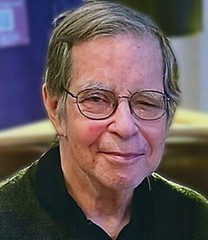 "Jim was a soft spoken, very decent but really intelligent and astute collector who many of you know had an exceptional collection of Massachusetts Half Cents that Heritage will also be selling.
"Jim was a soft spoken, very decent but really intelligent and astute collector who many of you know had an exceptional collection of Massachusetts Half Cents that Heritage will also be selling.
"I knew Jim since my large cent days. He was always fair, honest and a bit pricey but always had exceptional material. We tended to do most of our business before and after big auctions. Resorting and trading up or down.
"He almost convinced me early on to get into half cents rather than New Jersey Coppers…..for a minute…. ;-)
"Rest In Peace Jim."
Alan V Weinberg writes:
"I've known Jim for many decades. One of the nicest, most evenly tempered guys and true numismatists I've ever known.
"For perhaps five years I'd been urging him to finally auction his magnificent half cent collection.
"He nodded, agreeing with the assessment but just wanting to wait a little longer. Unfortunately, he will never see the classic auction catalogue, destined to be a reference, or watch his coins pass to a new generation like Bernard Edison aka Tettenhorst
was able to do."
Tony Terranova of New York City writes:
"I first met Jimmy at a Lanham Maryland coin show in 1972-3. Pretty sure I bought the cleanest surface, superb color, completely defect-free Massachusetts 1/2 cent 5-A in XF plus grade, with a cud. Kept that coin for 27 years. He was a superb dealer and a pleasure to deal with. He also became one of the finest friends a man can have. Will miss him greatly!!! "
Thanks, everyone. Jim will be missed. -Editor
To read the earlier E-Sylum article, see:
JAMES R. MCGUIGAN (1944-2022)
(https://www.coinbooks.org/v25/esylum_v25n11a03.html)
Lilley Improved Order of Red Men Token
"There is only one listing in the online token catalog, tokencatalog.com, that mentions M.C. Lilley but it is a very interesting one from a gathering of the Improved Order of Red Men, a fraternal organization, in Bridgeport, Connecticut. According to Google books, this event was in 1907.
"61ST GREAT SUN COUNCIL / C.C.U.S. / IMP. O.R.M / BRIDGEPORT, CONN. / CORN MOON C.S.D. 417 / COMPLIMENTS OF / THE M.C. LILLEY / & CO. / COLUMBUS, O. (bust of Indian in full headdress) copper 32mm"
Thanks - interesting item and organization. -Editor
To read the complete catalog entry, see:
Columbus, Ohio (Franklin County), U.S.A. (also attributed to Bridgeport, Connecticut)
(http://tokencatalog.com/token_record_forms.php?
action=DisplayTokenRecord&td_id=522702&inventory_id=586091
&td_image_id=401044&attribution_id=539792&record_offset=1)
Bitcoin Seller's Remorse
Ben Keele writes:
"The entries in The E-Sylum about physical crypto tokens reminds me of what was probably the biggest financial error I've made in my life thus far.
"Back in 2011 (I think--I wish I'd kept better records), I bought 2 bitcoin tokens for $6 on eBay. I thought it was funny that supposedly digital currency had still been reduced to physical form. I thought it was a curiosity.
"A few years later, I found out bitcoin was now $40 a unit. I peeled off the holographic stickers, loaded the bitcoin into a digital wallet, and sold them for $80. I thought I had received a great windfall, and I still had the tokens.
"Another year or two later, I noticed on eBay these tokens, even when the bitcoin had been redeemed and sold, were selling for $100 each. I quickly sold both tokens, reveling in my good fortune.
"Now, of course, I know much more about bitcoin, cryptocurrencies, and blockchain. I don't have the over $30,000 per bitcoin or over $1,000 per redeemed brass tokens (just checked eBay again), but I do have a funny story. If I keep telling it, maybe someday I'll get the price of each telling under $1,000"
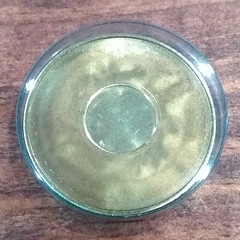
Yikes! We're all kicking ourselves for not putting together a denomination set... And I know how you feel after holding 100 shares of Tesla for two years, and selling at a slight loss a year or two before it finally took off. Right place, wrong time. -Editor
To read the earlier E-Sylum articles, see:
2012 GOLD CASASCIUS 1000 BITCOIN GRADED
(https://www.coinbooks.org/v24/esylum_v24n41a12.html)
PHYSICAL BITCOINS, BOGGS, AND EXPENSIVE PIZZA
(https://www.coinbooks.org/v24/esylum_v24n42a07.html)
2013 SILVER LEALANA 0.1 BITCOIN OFFERED
(https://www.coinbooks.org/v24/esylum_v24n46a20.html)
LEALANA BITCOIN SET OFFERED
(https://www.coinbooks.org/v24/esylum_v24n52a26.html)
Here's the Monday, March 14th, 2022 Bizarro cartoon. -Editor
For more Bizarro, see:
https://comicskingdom.com/bizarro
STACK'S BOWERS SPRING 2022 PHYSICAL BITCOINS
Here's the press release for the Stack's Bowers offering of physical bitcoins in their upcoming Spring 2022 sale. -Editor
in the Stack's Bowers Galleries Spring 2022 Auction
Stack's Bowers Galleries is proud to present an exciting selection of physical bitcoins and other cryptocurrency in their Spring 2022 Showcase Auction, the Official Auction for the Whitman Coin & Collectibles Expo. The sale will feature an array of Bitcoin and Litecoin from the popular Lealana and Casascius series, all certified and encapsulated by PCGS. Also included are several unloaded and redeemed coins that remain very popular as keepsakes of this exciting technology.
This is poised to be the largest and most diverse offering of physical cryptocurrency ever by a major auction house, confirming Stack's Bowers Galleries as a market leader among today's expanding community of collectors. The 500% premium realized by a Lealana 0.1 Bitcoin in the firm's November 2021 sale indicated tremendous excitement for this new category, and strong premiums are expected from crypto collectors and traditional numismatists alike in this April offering.
The selection of Casascius coins is highlighted by a 2013 1 Bitcoin and a 2013 0.5 Bitcoin that were purchased directly from Mike Caldwell, the creator of the series, as part of original rolls of coins. They are accompanied by two of the historic 2011 Casascius Error 1 Bitcoin pieces, which are important as the first funded physical bitcoin ever produced, according to researcher Elias Ahonen's Encyclopedia of Physical Bitcoins and other Crypto-Currencies. Included in this pair is a MS-66 (PCGS) specimen that ranks as the sole finest of just five at PCGS.
The Lealana coins are spotlighted by a scarce four-coin set of silver 2013 Lealana bitcoins. The coins will be offered individually in consecutive lots, though an advanced collector could potentially acquire all four coins and keep the set intact. Included are a 0.1 BTC graded Proof-70 Deep Cameo (PCGS), a 0.25 BTC graded Proof-69 Deep Cameo (PCGS), a 0.5 BTC graded Proof-70 Deep Cameo (PCGS), and an important gold-plated 1 BTC graded Proof-69 Deep Cameo (PCGS). The last is described by specialist Elias Ahonen as "perhaps the most visually interesting" issue from this series. Each coin is marked with the serial number 24, making it one of the earliest sets issued by Lealana creator Noah Luis, aka "smoothie."
Stack's Bowers Galleries is also excited to offer their clients the ability to pay for their purchases with Bitcoin. The firm has arranged with BitPay to facilitate all Bitcoin payments and a 1% fee will be added to all invoices for this service. Additional terms and conditions apply, and bidders are required to contact Stack's Bowers Galleries before the sale with any questions relating to payment via BitPay. Clients who would like to settle an invoice via BitPay must contact the firm's accounting department to arrange for a payment request.
This historic offering of cryptocurrency coins will be presented at the end of the Stack's Bowers Galleries Rarities Night session, which opens for live bidding at 2:00 PM PT on Tuesday, April 5. The entire Rarities Night session is now available for viewing and pre-bidding at the firm's website. For more information about this offering of physical cryptocurrency or to consign your cryptocurrency to a future sale, contact Stack's Bowers Galleries at consign@stacksbowers.com or 800-566-2580.
To read lot descriptions, see:
2011 Casascius 1 Bitcoin (BTC). Brass. Loaded (Unredeemed). Firstbits 1Att3xxP. Series 1. CASACIUS Error. 28.5 mm. MS-66 (PCGS).
(https://auctions.stacksbowers.com/lots/view/3-VJGGN/2011-casascius-1-bitcoin-btc-brass-loaded-unredeemed-firstbits-1att3xxp-series-1-casacius-error-285-mm-ms-66-pcgs)
2013 Lealana "Gold B" 1 Bitcoin (BTC). Gold-Plated Silver. Loaded (Unredeemed). Firstbits 1BTCP6vy. Serial No. 24. Black Address, Serial...
(https://auctions.stacksbowers.com/lots/view/3-VJGMR/2013-lealana-gold-b-1-bitcoin-btc-gold-plated-silver-loaded-unredeemed-firstbits-1btcp6vy-serial-no-24-black-address-serial)
ANS NAMES ELKINS AS DEPUTY DIRECTOR
The ANS has named a new Deputy Director. Here's the press release. -Editor
ANS Announces Dr. Nathan T. Elkins as Incoming Deputy Director
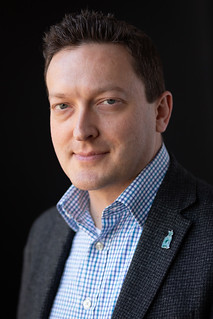 The American Numismatic Society (ANS) is pleased to announce Dr. Nathan T. Elkins will be joining the ANS full time as Deputy Director, effective on June 1, 2022. Currently Associate Professor of Art History (Greek and Roman) at Baylor University in Waco, Texas, Dr. Elkins has been at the ANS as Visiting Research Scholar since August 2021.
The American Numismatic Society (ANS) is pleased to announce Dr. Nathan T. Elkins will be joining the ANS full time as Deputy Director, effective on June 1, 2022. Currently Associate Professor of Art History (Greek and Roman) at Baylor University in Waco, Texas, Dr. Elkins has been at the ANS as Visiting Research Scholar since August 2021.
Dr. Elkins brings to the role of ANS Deputy Director a record of organizational, managerial, and policy experience, as well as a long-term commitment to numismatic research and a history of support to the ANS community. Dr. Elkins has directed the Allbritton Art Institute at Baylor University since 2020. He previously directed the university's Undergraduate Research and Scholarly Achievement program from 2018 to 2020. He served on numerous university committees at Baylor, including the Faculty Senate and its Executive Committee, and he has been on a number of other academic boards and committees nationally.
He initially joined the ANS as a member in 2003 and, after twelve years of active membership and substantial contributions to numismatic scholarship, he was elected a Fellow of the Society in 2015. In addition, he was elected a Fellow of the prestigious Society of Antiquaries of London in 2020. He has been a guest lecturer at the Eric P. Newman Graduate Summer Seminar in Numismatics on several occasions and he was a student at the Summer Seminar in 2004. Dr. Elkins has also served the ANS as co-editor of the American Journal of Numismatics, the Society's annual peer-reviewed research journal, since 2018.
A prominent scholar of Roman coinage, Dr. Elkins' work examines the political and communicative significance of numismatic imagery in the broader context of art, architecture, literature, and social history. Among Dr. Elkins' books are Monuments in Miniature: Architecture on Roman Coinage (ANS Numismatic Studies 29, 2015), The Image of Political Power in the Reign of Nerva, AD 96–98 (Oxford University Press, 2017), and A Monument to Dynasty and Death: The Story of Rome's Colosseum and the Emperors Who Built It (Johns Hopkins University Press, 2019). He is now working on a book on the significance of Libertas (Liberty) on Roman coinage. Active in archaeological fieldwork, he is currently the staff numismatist at the Huqoq Excavation Project in Israel and the 'Ayn Gharandal Archaeological Project in Jordan.
I am a firm believer in the work of the ANS,
Dr. Elkins noted, which has long been an international leader in numismatic research and innovation. I am grateful for the opportunity to join the amazing line of professionals among the ANS staff, and look forward to collaborating with the Executive Director to advance and strengthen the Society's mission and vision.
Executive Director Gilles Bransbourg said, Nathan Elkins is an incredible addition to the team at the ANS. Bringing him into the permanent staff means we can focus further together on developing organizational strategies and growing our programs in a way that we have aspired to but now have more hands available to bring to fruition. He has been giving his time and energies to the ANS for many years and few people are as deeply familiar with our field of study as Nathan is.
For more information on the American Numismatic Society, see:
http://numismatics.org/
VOCABULARY TERM: HUMAN FIGURE
Here's another entry from Dick Johnson's Encyclopedia of Coin and Medal Terminology. -Editor
Human Figure. The human form – face or figure – is the most used device on coins and medals. Portraits, heads, busts, partial figures, full figures appear on numismatic items more than any other class of objects and this has been so since the time of Alexander the Great – and one of his governors who placed his portrait on a coin, the first living person to do so. The term effigy applies to all views of the human body with the exception of the head, face or portrait.
Most every ruler since that early time has appeared on a coin; in fact, it is the only surviving likeness of some rulers. We learn portraiture – what rulers and other famous people of history looked like – from coins and medals, most all other forms of contemporary portraiture having since disappeared. The first Renaissance medals, by Pisanello, were portrait medals. Thus we know what Columbus looked like only because of his portrait on a contemporary medal. We know what Ceaser or Cleopatra looked like for their portraits on coins.
Human beings recognize each other by characteristics, the face contains the most perceptive characteristics. Thus heads on coins and medals can show the most recognizable details. A bust on a small object reveals less facial details but more of the body or clothing. A full figure in such small size can reveal little facial characteristics, but more of the figure in a position recognizable for that person (in a sports position, or on horseback, for instance).
The human figure is also shown as a seated figure, or kneeling figure in addition to topical positions. As such they are often shown with attributes to aid identification, or subsidiary devices to add ornamentation. The designer of a coin or medal has a wide choice for the most appropriate position of the person being portrayed.
Cataloging the human figure. The human figure is described by its position: facing, or turned to one side or the other (see chart). The length of the figure is also noted in describing: head, bust, half length, three-quarter length or full length. It is also described by its costume or covering – clothed, draped or nude. See also portraits and portraiture.
If the human figure is not that of a person, once living or dead, but is more of an example of everyman, it is said to be representative, like a representative view. Such an image is symbolic of all people. In cataloging, the human figure must be identified or noted as exemplar, typical of all man.
To read the complete entry on the Newman Numismatic Portal, see:
Human Figure
(https://nnp.wustl.edu/library/dictionarydetail/516074)
HARVEY STACK'S NUMISMATIC FAMILY, PART 117
Stack's Bowers has a backlog of Harvey Stack's numismatic memoir articles and will continue publishing them. In this one Harvey discusses auction sales of 1994. -Editor
 The year of 1994 provided Stack's with a great selection of auctions, eight public sales, all conducted in New York City. These were made up of two international sales as well as six that featured items from the United States, with specialized collections, most of which had been assembled from the 1950s through the 1980s. The highlight collection was major portions of the renowned James A. Stack Collection of United States Gold, Silver and Copper Coins, as well as an important offering of English gold and silver coins, all in outstanding condition. The James A. Stack, Sr. Collection was started during World War II and then built over several decades with his son and other members of his family. James A. Stack , Jr., took over the management of the collection and sold portions of it in various Stack's sales. While we shared similar Irish heritage, neither James, Sr., nor James Jr. was any relation to our Stack family. But over time they relied on us to help build and enhance the collection and, as with many of our clients, we came to feel like family.
The year of 1994 provided Stack's with a great selection of auctions, eight public sales, all conducted in New York City. These were made up of two international sales as well as six that featured items from the United States, with specialized collections, most of which had been assembled from the 1950s through the 1980s. The highlight collection was major portions of the renowned James A. Stack Collection of United States Gold, Silver and Copper Coins, as well as an important offering of English gold and silver coins, all in outstanding condition. The James A. Stack, Sr. Collection was started during World War II and then built over several decades with his son and other members of his family. James A. Stack , Jr., took over the management of the collection and sold portions of it in various Stack's sales. While we shared similar Irish heritage, neither James, Sr., nor James Jr. was any relation to our Stack family. But over time they relied on us to help build and enhance the collection and, as with many of our clients, we came to feel like family.
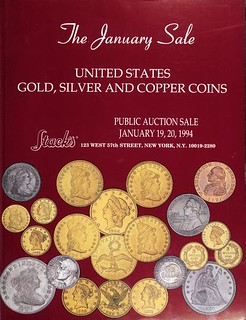 But I am getting ahead of myself, as there were quite a few fine sales that preceded the James A. Stack sale in 1994. The year started off with our January sale of the Huntington, Sun City and the Williams and Poole Collection. Offered was an extensive choice type coin collection together with a variety of pattern coins, all of high quality and for certain series full sets, including original Proof sets from the 19th century. The Sun City Collection had virtually complete sets of gold dollars and 20th century gold and was highlighted by an important offering of United States half eagles, 1795 to 1837, with varieties, a virtually complete group of eagles, 1795 to 1804. This first sale of 1994 had over 2,000 lots and there was great quality among the many popular and rare coins. Our March sale featured an unusual type set of U.S. gold coins, especially rich in high quality pieces, with many additional dates and mints, and including pieces rarely seen at public auction. In total there were over 1,800 lots.
But I am getting ahead of myself, as there were quite a few fine sales that preceded the James A. Stack sale in 1994. The year started off with our January sale of the Huntington, Sun City and the Williams and Poole Collection. Offered was an extensive choice type coin collection together with a variety of pattern coins, all of high quality and for certain series full sets, including original Proof sets from the 19th century. The Sun City Collection had virtually complete sets of gold dollars and 20th century gold and was highlighted by an important offering of United States half eagles, 1795 to 1837, with varieties, a virtually complete group of eagles, 1795 to 1804. This first sale of 1994 had over 2,000 lots and there was great quality among the many popular and rare coins. Our March sale featured an unusual type set of U.S. gold coins, especially rich in high quality pieces, with many additional dates and mints, and including pieces rarely seen at public auction. In total there were over 1,800 lots.
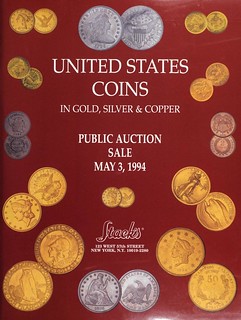 Our May sale brought to the auction block just under 1,000 lots of United States coins in gold, silver and copper. While the cover did not feature name collections, like so many of our sales it offered our clients opportunities to add to their collections across many series and at many different price levels. Our next sale was for the newly formed Spring Metropolitan International Numismatic Convention in June where we were pleased to present 2,314 lots in total, split between United States coins and foreign and ancient coins. Name cabinets included those of Dr. Alfred Globus, Ellis Randels, Alfred Samuel Binder, and the Ford Family Trust. Featured in the catalog were original Proof sets 1876-1915 (almost complete) and an extensive offering of U.S. patterns that included a set of Amazon designs in Gem condition. This sale attracted collectors and dealers from all over the United States and the world who came to New York City to try to acquire some of the rare and unusual items being offered. The convention attendance was one of the largest held that year.
Our May sale brought to the auction block just under 1,000 lots of United States coins in gold, silver and copper. While the cover did not feature name collections, like so many of our sales it offered our clients opportunities to add to their collections across many series and at many different price levels. Our next sale was for the newly formed Spring Metropolitan International Numismatic Convention in June where we were pleased to present 2,314 lots in total, split between United States coins and foreign and ancient coins. Name cabinets included those of Dr. Alfred Globus, Ellis Randels, Alfred Samuel Binder, and the Ford Family Trust. Featured in the catalog were original Proof sets 1876-1915 (almost complete) and an extensive offering of U.S. patterns that included a set of Amazon designs in Gem condition. This sale attracted collectors and dealers from all over the United States and the world who came to New York City to try to acquire some of the rare and unusual items being offered. The convention attendance was one of the largest held that year.
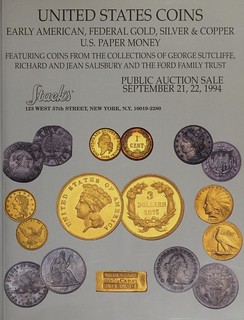 In September we brought to auction a group of important consignments of early American and federal gold and silver coins as well as U.S. paper money. There were specialized collections that complemented each other as well as attracting a wide variety of bidders both in person and by mail and phone. The George Sutcliffe Collection was begun when George's uncle introduced him to collecting small cents at the age of 6. His desire to expand in the hobby grew as he became older and he assembled a comprehensive cabinet of copper, silver and gold U.S. coins in high quality and with numerous rarities. It was a great introduction to the sale in September.
In September we brought to auction a group of important consignments of early American and federal gold and silver coins as well as U.S. paper money. There were specialized collections that complemented each other as well as attracting a wide variety of bidders both in person and by mail and phone. The George Sutcliffe Collection was begun when George's uncle introduced him to collecting small cents at the age of 6. His desire to expand in the hobby grew as he became older and he assembled a comprehensive cabinet of copper, silver and gold U.S. coins in high quality and with numerous rarities. It was a great introduction to the sale in September.
Next to be offered was the gold coin collection of Richard and Jean Salisbury. This couple had worked together to build this cabinet, with Jean accompanying Richard to many auctions. I remember one Stack's auction where Jean purchased the rare 1875 Proof $3 piece to give to Richard for his birthday. Besides completing a set of gold dollars, with all dates and mints, they completed a set of $3 gold pieces, highlighted by superb examples of the rare 1854-D, and Proof 1875 and 1876 and including many choice Mint State and Proof coins. This numbered among the finest sets offered at sale for several decades, although it was lacking the unique 1870-S. The couple also amassed full sets of the gold coins of Dahlonega, Charlotte and Carson City, and a good number from Philadelphia and New Orleans. This collection, along with the other consignments to the sale, made an exciting offering to start the fall season and we received a great number of bid sheets as well as people participating in person. But the fall season was about to get even better, as I will describe in my next article.
To read the complete article, see:
Growing up in a Numismatic Family: Part 117
(https://www.stacksbowers.com/News/Pages/Blogs.aspx?ArticleID=growing-up-in-a-numismatic-family-part-117)
To read the earlier E-Sylum article, see:
HARVEY STACK'S NUMISMATIC FAMILY, PART 116
(https://www.coinbooks.org/v25/esylum_v25n10a19.html)
THE BOOK BAZARRE
DON EVERHART'S CAREER IN COINS, PART 8
With permission, we're republishing excerpts of former U.S. Mint Sculptor-Engraver Don Everhart's series published by CoinWeek beginning in April 2018. -Editor
Presidential Medals
Before I worked at the U.S. Mint, in 1996, I designed and sculpted the Second Administration Inaugural Medal of Bill Clinton and Albert Gore. It was quite an honor for my work to be chosen and I felt it might be one of the only chances I would get to work on such a high-profile commission. When I was freelancing I would occasionally work on what I considered to be important commissions. But after I became a United States Mint Engraver I sincerely thought that everything I worked on was important. My work would become a part of the narrative of our country's history.
On the third floor of the Philadelphia Mint is a room called The Presidents Room
. It was where the Mint would hold special meetings (and still does), and where news stories are often filmed. It is a beautiful room, with parquet floors, period furniture, and American flags. One wall in The Presidents Room is lined with plaster and galvano models of all the U.S. presidents. Many times I would enter the room and marvel at the work that was done previously by some of the giants of American medallic sculpture. Works by John Sinnock, Gilroy Roberts, Charles Barber, George Morgan and many others adorn the wall.
George W. Bush (2001-2009)
In 2008 I was asked to sculpt the portrait of the George W. Bush Second Administration Presidential Medal. These medals differ from the Official Inaugural Medal. The Presidential Medals honor the past Presidents of the United States and are produced by the United States Mint. The official Inaugural Medals, however, are produced by private mints and are usually an open competition. As in my with Clinton-Gore mentioned above, the medals are produced by an independent artist and struck by a private mint, then presented to the Official Inaugural Committee of the president-elect. The sculpting is done on spec (you don't get paid unless your medal gets chosen).
After she retired, Donna Weaver's obverse design for the Second Administration Medal of George W. Bush was chosen as the winner. Since she was retired and no longer on the Mint staff, she was no longer eligible to execute the sculpt. In a case like this another staff artist at the U.S. Mint is designated to do the sculpting.
I sculpted Donna's design, a dramatic profile of the president looking slightly down and to the right. The design had a border that contained the wording George W. Bush
and two stars to indicate that it represented his second administration. Donna did great work for the Mint. She is a top-notch designer and sculptor.
Donna and I, along with Director Moy, all received invitations to meet with the president in the Oval Office on his last official full day in office, January 19, 2009. After a short wait outside, we were ushered into the room. The president was in a good mood, joking with Ed as we walked in. Bush was very jovial, relaxed, and engaging. I felt that he was feeling quite relieved to be leaving office and to have this burden lifted from his shoulders. He gave us presidential buttons, cuff links and tie tacks as parting gifts, and we posed with him for photos. After about 20 minutes we left.
About a month or so later, I received from him a signed photo of myself standing next to the president and a hand-signed note thanking me for the work I had done, telling me he intended to display the medal in his future George W. Bush Presidential Center. I realized that no matter what one's politics are, these men are flesh and blood human beings with human feelings. We can never comprehend the pressures and stress that they endure as leaders of the free world.
Being invited to the Oval Office by the President for work I had done was be the ultimate compliment and definitely the height of my career. Like I said, this was a huge honor for me. I only had one reservation, however. Sure, I sculpted the Bush portrait but it was not my original design. It's the curse of never being satisfied…
To read the complete original article, see:
Don Everhart: My Career in Coins, Part 3 – Historic Figures & Heads of State
(https://coinweek.com/us-mint-news/don-everhart-my-career-in-coins-part-3-historic-figures-heads-of-state/)
To read the earlier E-Sylum article, see:
Don Everhart's Career in Coins, Part 7
(https://www.coinbooks.org/v25/esylum_v25n11a13.html)
SUBSCRIBER PROFILE: RICHARD LOBEL OF COINCRAFT
It's been a long while since we've run a profile of one of our subscribers. Here's a great one provided by Richard Lobel of Coincraft in London. -Editor
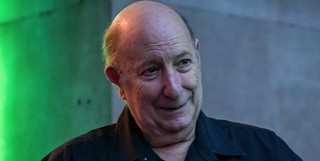 I arrived in London, England on the 2nd of October 1968. I came 3rd class by ship from New York to Southampton and then by boat train to London.
I was born in Cambridge but grew up in Newton and Boston, Massachusetts.
I arrived in London, England on the 2nd of October 1968. I came 3rd class by ship from New York to Southampton and then by boat train to London.
I was born in Cambridge but grew up in Newton and Boston, Massachusetts.
I went to Boston University, I dropped out once and was asked to leave twice before I got my degree in International Business and Macro Economics. I was going for my MBA when I realised that I would rather go to India and sit at the foot of a guru. London was just a stopover on the way to India. But it would be more than 40 years until I actually made it to India.
London in the 1960's and 1970's was a wonderful place to live, the nightlife was outstanding. Most of my awake time was when it was dark. I had total assets of $4,000 of which I owed my aunt and the bank $7,000 so I guess I was technically broke. I was young and fearless and if you worked hard you could make a living. The bonus is London is a magical place to live. Before going to London I had spent a little time in Haight-Ashbury, San Francisco, I was, I admit, quite wild in my youth. I grew up in the 1960's. I travelled all over the world buying and selling rare coins and banknotes, I used to do 250,000 kilometre's a year. I flew to Los Angeles from London almost once a month, because that was where the money was and the young ladies were so Californian. In those days they even had coin groupies and I was young and the world was a different place at that time!
I am proud to have attended with a bourse table at the first all foreign show ever held in the United States: C.O.I.N. (Convention of International Numismatists) Los Angeles. That was the show where Clyde Hubbard broke out the Guatemala colonial coin hoard. Outstanding quality, just dazzling coins. I have also attended the first coin fair held in Japan, as well as the first German coin fairs held in Hamburg, Berlin, Munich and Hanover and of course not forgetting Singapore. The legendary M. Oka from Japan ran one hell of a show in Singapore, let me tell you. The coin fair was, as his daughter's wedding which I had the honour of attending, was first class. He is one of my real heroes, despite the age difference, he always treated me as an adult, even occasionally when he had to correct me.
It was not unusual for me to visit three different countries in Europe in a single weekend, while swinging a 20 kilo bag so it looked light enough to be classed as hand luggage. I made it my business to get to know and talk to coin dealers from all over the world and become friends with many of them to this day. It was a wild and hectic time, until I woke up one morning and didn't know what country I was in, let alone which city. It was time to slow down and concentrate on my British business. I cut back on the travel and started to publish rare coin lists.
I am not a regular joiner of organizations, but in January of 2022 I celebrated my 50th anniversary of being a life member of the ANA (LM 1038). I remember John Pittman convincing me to convert from a regular to a life membership of the ANA. Those who knew John may find this next part hard to believe. That night he bought the champagne! I am also member 229 of the PNG and have been a member since 1974. I have known some of the most interesting, intriguing and exotic coin dealers from all over the world. I could tell you some stories… I have had many wonderful experiences all over the world. Even when in 1963 they arrested me in Honduras as a suspected Castroite all because I had a beard. All I wanted to do was buy and sell coins. I wasn't all that interested in politics.
In the coin business I have been up and down, but finally figured it out with help from my fantastic wife Claire. As of January we have been married 42 years. She is a Saint to put up with me and my antics. Remember that we live and work together. Claire is a worldwide expert on banknotes and heads our banknote department. One day in 1982 my old company (Museum Galleries) finally went broke. At that time and as a good client of our bank, we were only being charged 24% interest per annum. I personally lost £4,000,000 the day Museum Galleries went bust. But Claire and I started up again. We bought some empty coin boxes to put on the shelves, letting people think we had something in stock. It was one of the most important times in my life my, when I realized I had to grow up. We learned who our real friends were and who wanted to kick you when you are down, I have a very long memory. We worked seven days a week to re-build the business and I am so proud of the company we have built: Coincraft – Britain's Coin Shop – the coin shop you used to remember.
When the Guinness Book of Records listed rare coins and banknotes, I was listed 14 separate times. I have handled some of the rarest British and world coins and banknotes in existence. The Central Bank of the Philippines built a room onto their museum to house a collection of Philippines banknotes under Spanish rule I sold them. Previously these banknotes were only thought to exist. But I grew tired of that way of doing business and wanted a change.
I love buying, yes everyone likes to buy, but I LOVE buying. I love buying a hoard of 1,000 coins and selling them one by one to collectors. Think of how many collectors I can make happy. Today we only deal with collectors and most of the items we sell are under £5,000, many under £200. In fact I think the most expensive coin we sold last year was £70,000. My memory is too long for some of today's ‘so-called rarities'. Today they talk in hush terms about the British gold £5 of 1839 – the so-called Una and the Lion gold coin. Examples have sold for up to a million dollars at auction. But I remember the fabled coin dealer Geoffrey Hearn taking 3 of them out of his pocket and saying he wanted £1,800 for them. Not each, but £1,800 for the three Una and the Lions, but then again who had £1,800 in those days… How rare a coin is it really?
Today we carry the largest stock of coins and banknotes in Britain and each year we publish more than 40 catalogues. We have 25 staff and last year opened a new mail order facility of 5,000 square feet in the centre of Covent Garden, that is Not open to the public. If you like numbers we handle about 35-40,000 orders a year. We do not borrow any money and are totally self-financing. The first coin I struck was the 1965 Cuban Souvenir Peso, along with the late Richard Margolis and Paul Weinstein. Since then, in Colin Bruce's Unusual World Coins, I believe there are more than 125 listings of coins that I have issued.
I am perhaps best known for handling the partial set of Edward VIII coins three times, I should have stopped after two. My personal collection of Edward VIII memorabilia is the second finest in the world, the Royal Family of course has the finest. But my collection of Edward VIII medallions is the finest in the world. In addition I have struck somewhere between 250-350 different medallions on many themes and in many metals, including of course Edward VIII pieces. I am trying to remember all the medals I have had struck, but it is difficult and I keep finding ones I had forgotten.
My Father went to university with Maurice ‘Murry' Gould of Copley Coin Co, who wrote the first catalogues on Hawaiian, Alaskan and Puerto Rican coins for the Whitman series of black books. He was one of my early mentors. I am also proud to say that Mike Berton, formerly of J. J. Teaparty and David Laties of Educational Coin Co. have been my friends for more than 60 years. In this country my great mentor was Peter Gerald ‘Maundy' Allen. There were many very kind dealers all over the world who would try and help this reprobate, to all of them I say ‘Thank you, we didn't do too bad'.
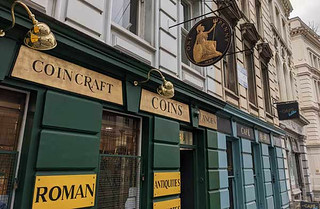 Coincraft is a family owned and family run business that has been around in one form or other for 66 years. I had my first paid subscription to a coin publication, The Numismatic Scrapbook Magazine, in 1955. I consider this to be the finest coin publication ever printed, its owners were most fantastic. I have handled more hoards of coins and banknotes than most dealers can shake a stick at, most you will never hear about. I may well have been involved with one of the hoards listed at the front of The Red Book, but then again, maybe not. After 54 years of living in England, I have learned to try and be somewhat discreet. Of course over the years I have seen and heard a lot of interesting things.
Coincraft is a family owned and family run business that has been around in one form or other for 66 years. I had my first paid subscription to a coin publication, The Numismatic Scrapbook Magazine, in 1955. I consider this to be the finest coin publication ever printed, its owners were most fantastic. I have handled more hoards of coins and banknotes than most dealers can shake a stick at, most you will never hear about. I may well have been involved with one of the hoards listed at the front of The Red Book, but then again, maybe not. After 54 years of living in England, I have learned to try and be somewhat discreet. Of course over the years I have seen and heard a lot of interesting things.
I love numismatics and consider myself a numismatist as well as a coin dealer. The coin business has been very good to me, I could never have done it without the help of my long suffering wife and my excellent staff. Anyone who has seen how I work, has never used the words ‘organized' or ‘neat', when describing me. A friend once said to Claire that if he owned the business ‘he would fire me'. I told Claire to tell him ‘he wouldn't'. He asked ‘why?' and I replied ‘because I make the company too much money'. Well at least I am good at something…
To read earlier E-Sylum articles, see:
WACKS AND LOBEL ON COLIN R. BRUCE II
(https://www.coinbooks.org/v20/esylum_v20n39a17.html)
INTERVIEW: RICHARD LOBEL OF COINCRAFT
(https://www.coinbooks.org/v22/esylum_v22n17a19.html)
MORE ON EDDIE ‘J.J. TEAPARTY' LEVENTHAL
(https://www.coinbooks.org/v23/esylum_v23n19a21.html)
RICHARD LOBEL ON HANS AND JACQUES SCHULMAN
(https://www.coinbooks.org/v24/esylum_v24n03a08.html)
To visit the website of Richard's CoinCraft, see:
https://www.coincraft.com/
TYRANT COLLECTION OWNER DAN O'DOWD
An article in the British newspaper The Telegraph introduces American software billionaire Dan O'Dowd as the builder of the famed Tyrant Collection. -Editor
A tech billionaire known as the Tyrant
has finished the first coin collection spanning the entirety of English and British history, with an array of currency more complete than that of the Royal Mint.
Coins minted by every monarch – all the way back to 7th-century Anglo-Saxon kings – have been compiled by the secretive collector to form part of a £300 million set known as the Tyrant Collection
.
The mysterious figure behind the set, until now known only as the Tyrant
in the numismatic community, has been unmasked as a US tech billionaire who has spent the past 17 years assembling the most valuable coin hoard in the world.
Dan O'Dowd kept both his identity and his ambition to own a coin featuring every English and British monarch secret to avoid being held to ransom on the price, but the designer of software for fighter jets has revealed himself after completing his dreamed-of collection.
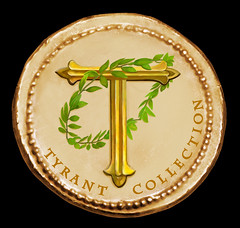 He said:
He said: Bill Gates builds a house, Jeff Bezos builds a yacht, everybody has something they want to do. I didn't really want to buy a yacht because I get seasick. I collect coins.
It's my hobby, it's my release. It's completely separate from everything I do in business. It's just something that's always fascinated me.
The founder of Green Hills Software, which provides technology for nuclear bombers, is worth around £1.5 billion, and has been collecting the world's rarest coins since 2005. His 1,000-strong collection of coins minted by this country's rulers has examples dating back beyond the Royal Mint's 1,100-year history, and includes currency issued by obscure 7th-century Kentish king Eadbald, and Mercian ruler Offa.
Encompassing currency from the nine-month rule of Harold Godwinson, and surviving pieces from the brief reign of abdicant king Edward VIII, the Tyrant Collection is the largest in private hands and rivals that of institutions such as the British Museum.
Mr O'Dowd, who ordinarily keeps a low profile because of his military and government work, has managed to keep his passion for coin collecting equally secret. He said: When you build a coin collection, if you're too big, and people find out what you are doing, they can hold you up.
If anyone knew what I was doing, the collection I was trying to build – they could charge me whatever they want. They could extort me on every coin because they would know I needed that coin or I wouldn't have the complete set. I did it completely in secret. Nobody knew there was even a collection being built, so I managed to get it without being taken advantage of.
Oh yes, he has some ancient and U.S. coins, too. -Editor
To read the complete article, see:
Billionaire ‘Tyrant' unveils collection of coins minted by every English and British monarch
(https://www.telegraph.co.uk/news/2022/03/12/billionaire-tyrant-unveils-collection-coins-minted-every-english/)
To read earlier E-Sylum articles, see:
COINS OF THE TIGRIS AND EUPHRATES VALLEY
(https://www.coinbooks.org/v21/esylum_v21n20a30.html)
EAGLES OF THE TYRANT COLLECTION EXHIBIT
(https://www.coinbooks.org/v22/esylum_v22n49a19.html)
TYRANT COLLECTION U.S. TYPE COIN ANA EXHIBIT
(https://www.coinbooks.org/v24/esylum_v24n23a07.html)
NUMISMAGRAM MEDAL SELECTIONS: MARCH 2022
Jeremy Bostwick at Numismagram sent along these two spooky medals from his recent upload focused upon some of the more haunting aspects within the world of exonumia. For all of these new items, please visit numismagram.com/inventory. -Editor
101757 | GERMANY. Johann Friedrich Blumenbach bronze Medal. Issued 1825. Commemorating the Jubilee of the Anthropologist's Doctorate (50mm, 81.00 g, 12h). By G. Loos and H. Gube in Berlin. I FR BLUMENBACH NATO GOTHAE D 11 MAII 1752 DOCT CREATO GOTTINGAE D 19 SEPT 1775, bust left / NATURAE INTERPRETI OSSA LOQUI IUBENTI PHYSIOSOPHILI GERMANICI D 19 SEPT 1825, three human skulls, as classified by Blumenbach: Caucasian, Ethiopian, and Mongolian. Edge: Plain. Storer 398; Brettauer 125. Choice Mint State. Highly glossy and brilliant brown surfaces, with just a hint of rub on the high points. An ever-interesting and haunting type. $645.
Blumenbach was an anthropologist from the University of Göttingen and specialized in the study and classification of human skulls from around the world—later known as craniometry. At the time of his death, he owned 245 whole skulls and fragments, along with two mummies. The term ‘caucasian' as a descriptor of race was also derived from him, as his influential use of it in 1795 quickly caught on in scientific circles.
A classic piece. -Editor
To read the complete item description, see:
101757 | GERMANY. Johann Friedrich Blumenbach bronze Medal.
(https://www.numismagram.com/product-page/101757)
101904 | GERMANY. WWI satirical cast iron Medal. Issued 1916. Totentanz (Dance of Death) series: Death chokes Italy (69mm, 94.88 g, 12). By W. Eberbach. FÜR • LATEINISCHE • BUNDES • / TREUE / 1915 / TRIENT 1916 FRIAUL (for Latin loyalty 1915, Trentino 1916 Friuli), Death on its knees facing slightly left, choking the Lupa Romana (representing Italy) / Legend in five lines: AN / SIDNEY / SONNINO / DEN • REDEGE / WANDTEN (to Sidney Sonnino, the eloquent one); all within scaled polylobe. Edge: Some filing marks as made, otherwise plain. "The Art of Devastation," p. 263, no. 59; Frankenhuis 1499. Choice Mint State. Deep charcoal gray surfaces, with a delightful matte nature; a few light flecks on the reverse are mentioned merely for completeness. A rare piece from an increasingly desirable series. Compare to a similar example that realized a total of $2,640 in the 2021 Stack's Bowers ANA auction (lot 40404). $1985.
Similar to the satirical medallic issues of Karl Goetz, Walther Eberbach was inspired by the events of World War I to create a series of rather morbid medals to propagandize the German war effort. The theme upon which he decided to focus was the Totentanz, or "Dance of Death." This series of issues, a divergence from the ephemeral topic of vanitas, portrayed Death as a skeleton, quite gleefully taking joy in the demise of his enemies—the allied powers—rather than a subtle reflection upon life and death. This frank morbidity is expressed by Eberbach himself in a letter to Julius Menadier, in which he writes "...I want whoever holds the pieces in their hands years later to be overcome by the shudder grimness." It's safe to say that, in this desire, Eberbach was astoundingly successful.
After initially joining World War I one the side of the Triple Alliance/Central Powers, Italy, under her foreign minister, Sidney Sonnino, signed the Treaty of London in secret, which saw her switch sides and join the allied powers. Additionally, should the allies be successful, the treaty included plans to dismantle the Austro-Hungarian Empire, at least in part to Italy's benefit. The suggestion of this medal is that Italy (represented by the Lupa Romana—the fabled she-wolf that suckled the twins, Romulus and Remus) was receiving her payback for signing such a treaty, namely in the battering which she suffered at the hands of Austria-Hungary in the Trentino Offensive/Battle of Asiago in May–June 1916.
Creepy, and timely. -Editor
To read the complete item description, see:
101904 | GERMANY & ITALY. GERMANY. "Totentanz" satirical cast iron Medal.
(https://www.numismagram.com/product-page/101904)
KÜNKER AUCTION SALE 365: ANCIENT WORLD
Here's the first part of a massive KÜNKER press release for their April 2022 sales. -Editor
MONEY OF THE CELTS – The Flesche Collection at KÜNKER
The second part of KÜNKER's Spring Auction Sales is completely dedicated to antiquity. In addition to many collections of Greek, Roman Republican, Roman imperial and late Roman coinage, a collection with world-class Celtic coins will be on offer: the Flesche Collection.
The material on offer in the second part of KÜNKER's Spring Auction Sales from 4 to 6 April 2022 is presented by three auction catalogs with a total of more than 2,000 lots of ancient coins. Every lover of ancient coins will spot his favorite pieces in these three auctions.
Several interesting collections will be sold at once: auction 365 offers the Dr Albrecht Ullrich Collection with late Roman gold coins and the collection of a connoisseur with Roman coins including many rarities and a wealth of high-quality sesterces. Auction 366 is dedicated to a spectacular collection of Celtic coinage – collections like this one only enter the market once every few decades. The Flesche Collection contains what is readily described as showpieces
, and, indeed, the collection has been on display already in 2010 at the Munich State Coin Collection. Auction catalog 367 covers no less two collections: the Dr Guy Sylvain Paul Bastin Collection with Greek and Roman coins of wonderful quality and part 6 of the Dr W R Collection with Roman Republican coinage.
Catalog 365: Coins from the Ancient World
The second part of the Spring Auction Sales starts on 4 April with auction 365. It contains coins from the ancient world from various consigners, including some large collections. This auction covers the complete spectrum of ancient numismatics: Celts, Greeks, Romans, Byzantium and a few pieces of the Migration Period and the Orient.
As an example for the quality of the Greek coins on offer, we would like to draw your attention to a quintuple shekel or rather a decadrachm of the Carthaginians, minted in an unknown Sicilian mint. The extremely rare specimen graded very fine +
depicts a Pegasus on the reverse. Another highlight of the about 150 lots with Greek coins is an about extremely fine distater by Alexander the Great, minted during his lifetime by a Macedonian mint.
Added to attractive denarii and cistophori, the section of coins from the Roman Empire offers numerous aurei graded very fine to FDC, and an extensive series of exceptionally well-preserved sesterces – not only from the first and second but also from the third century. In addition to issues of Caligula, Claudius and all other male and female members of the Julio-Claudian and the Flavian dynasties, experts will also spot rarities such as a sestertius of Aelius and a double sestertius by Herennia Etruscilla.
A particularly rich selection of late Roman and Byzantine coins from the period after the death of Constantine the Great stems from the Dr Albrecht Ullrich Collection, who paid special attention to the perfect quality of his pieces during his many years of collecting coins.
No. 5070: Carthaginians / Sicily. 5 shekel (decadrachm), around 264 BC. Very rare. Very fine +. Estimate: 30,000 euros
No. 5087: Alexander III / Macedonia. Distater, 336-323, Macedonian mint. Very rare. About extremely fine. Estimate: 20,000 euros
No. 5226: Caligula. Sestertius, 37/8. From the collection of a connoisseur. Extremely fine. Estimate: 7,500 euros
No. 5232: Claudius. Sestertius, 50-54. From the collection of a connoisseur. FDC. Estimate: 12,500 euros
No. 5234: Claudius. Cistophorus, 41/2(?), Ephesus. From the collection of a connoisseur. Extremely fine +. Estimate: 7,500 euros
No. 5236: Agrippina the Elder. Sestertius, 50-54. From the collection of a connoisseur. Rare. Extremely fine. Estimate: 10,000 euros
No. 5253: Nero. Sestertius, around 65, Lugdunum. Very rare. Very fine + / About extremely fine. Estimate: 20,000 euros
No. 5264: L. Clodius Macer. Denarius, 68, Carthage. From MMAG auction 25 (1962), No. 591. Very rare. NGC XF*, Strike 4/5, Surface 5/5. Very fine. Estimate: 30,000 euros
No. 5395: Caracalla. Aureus, 199/200. From the collection of a connoisseur. Rare. Extremely fine. Estimate: 10,000 euros
No. 5405: Elagabal. Aureus, 220-222. FDC. Estimate: 25,000 euros
No. 5422: Herennia Etruscilla. Double sestercius, 249-251. From the collection of a connoisseur. Very rare. Extremely fine +. Estimate: 40,000 euros
No. 5446: Constans. Solidus, 340-350, Aquileia. From the Dr Albrecht Ullrich Collection. Rare. Extremely fine. Estimate: 2,500 euros
No. 5515: Aelia Pulcheria. Solidus, 414, Constantinopolis. From the Dr Albrecht Ullrich Collection. Rare. Extremely fine. Estimate: 5,000 euros
KÜNKER AUCTION SALE 366: MONEY OF THE CELTS
Here's the second part of the KÜNKER press release for their April 2022 sales. -Editor
Catalog 366: MONEY OF THE CELTS – The Christian Flesche Collection
This collection is a broadly designed cross-section of Celtic coinage and offers a selection of top-class key pieces of the finest and best of Celtic coin art. The specimens impress due to their select quality, great rarity and extraordinary historical significance. ... The collection covers the entire spectrum of Celtic coinage made from all coin metals, form bronze to silver and gold. ... The large volume of gold coins (more than 25%) is remarkable, just as the quality of perfectly minted bronze coins, which can rarely be found in this quality as they were used as everyday objects throughout history.
No, this was not written by an advertising copywriter but by Dr Rainer Cunz, then chairman of the Numismatic Commission of the Federal States of Germany, who has seen a lot of important collections.
The Christian Flesche Collection of Celtic coins truly is a world-class collection. And the collector was able to experience the joy of having one of the best experts in Celtic numismatics, Dr Bernward Ziegaus, review the material for the scholarly world and, what's more, curate an exhibition of these pieces at the Bavarian State Collection of Coins in Munich on the occasion of the completion of the publication.
Those who visited the exhibition in 2010/11 will remember the almost unbelievable quality of the material. One of the pieces shown then is still unique today. Dr Christian Flesche and the coin dealer Alois Wenninger, who assisted him, jointly enjoyed the perfectly preserved coins, whose motifs – as can be read in the exhibition brochure – are characterized by a ‘primitivism' that leans towards ornaments and seems downright modern today, being reminiscent of modern artists such as J Dubuffet or A R Penck.
Make your own judgement. Leaf through the incredible catalog. And if you are interested in the historical background of the coins, you should definitely buy the catalog of the Flesche Collection written by Bernward Ziegaus. His book is one of the best works on Celtic coins written in German.
No. 6049: Britain. Atrebates and Regini. Verica, 10-40. Gold stater, type Vine Leaf Viri
. About extremely fine. Estimate: 4,000 euros
No. 6096: Hispania. Emporion. Drachm, 2nd century BC. Very rare. About extremely fine. Estimate: 2,500 euros
No. 6119: Gallia. Gold stater after the model of the staters by Philip II. Type Gamshurst
, 3rd century BC. Very rare. About extremely fine. Estimate: 7,500 euros
No. 6199: Gallia. Parisii. Gold stater, around 60 BC. Very rare. Very fine +. 25,000 euros
No. 6236: Gallia. Treveri. Electrum stater, 60-25 BC. Extremely fine. Estimate: 10,000 euros
No. 6270: Helvetia. Gold quarter stater after the model of the staters by Philip II. Type à la rosette
, 2nd century BC. Rare. Very fine +. Estimate: 2,500 euros
No. 6326: Germania. Vindelici, rainbow cup – Gold stater 2nd/1st century BC. Very rare. Very fine +. Estimate: 7,500 euros
No. 6379: Germania. Vindelici, rainbow cup – Gold quarter stater, 150-50 BC. Very rare. About extremely fine. Estimate: 6,000 euros
No. 6412: Bohemia. Gold quarter stater, 140-120, Stradonice. Very rare. Worked at the edge. Very fine +. Estimate: 7,500 euros
No. 6495: Bohemia. Boii in the area of Bratislava oppidum. Iantumarus. Tetradrachm, 27/6. Very rare. Very fine to extremely fine. Estimate: 12,500 euros
No. 6496: Bohemia. Boii in the area of Bratislava oppidum. Fapiarix. Tetradrachm, ca. 25 BC. Very rare. Very fine +. Estimate: 25,000 euros
No. 6497: Bohemia. Boii in the area of Bratislava oppidum. Evoiurix. Tetradrachm, ca. 25 BC. Very rare. Very fine +. Estimate: 12,500 euros
No. 6503: Germania Magna. Cotini. Stater, type Dolny Kubin-Vel'ky Bysterec
, 1st century BC. Very rare. Very fine to extremely fine. Estimate: 10,000 euros
No. 6519: Noricum. Tetradrachm, type frontal face
, 2nd/1st century BC. About extremely fine. Estimate: 7,500 euros
No. 6535: Pannonia. Tetradrachm, type with curl on the cheek, 3rd century BC. Rare. About extremely fine/very fine. Estimate: 10,000 euros
No. 6560: Pannonia. Tetradrachm, type with inverted laurel wreath and arabesque curl, 3rd/2nd century BC. Extremely rare. Extremely fine. Estimate: 20,000 euros
No. 6708: Dacia. Tetradrachm, type double head with head stand
, 3rd/2nd century BC. Extremely rare. Very fine +. Estimate: 10,000 euros
No. 6777: Colchis / Iberia. Gold stater, 2nd/1st century BC. Very rare. Extremely fine. Estimate: 15,000 euros
KÜNKER AUCTION SALE 367: GREEK COINS
Here's the third and final part of the KÜNKER press release for their April 2022 sales. -Editor
Catalog 367: Greek Coins of Beautiful Quality – The Dr Guy Sylvain Paul Bastin Collection
The Roman Republic – The Dr W R Collection, Part 6
KÜNKER's Spring Auction Sales will end on Wednesday, 6 April 2022 with the sale of two more collections. First are the coins of the Dr Guy Sylvain Paul Bastin Collection. He collected all the favorite pieces of collectors of Greek coinage in outstanding quality.
It's best to use the internet to really appreciate the quality of these pieces by zooming into the pictures. Let's have a look at one example: staters of the archaic coinage system from Sybaris are already rare to begin with. But the collector managed to acquire not a stater but a drachm from Sybaris – these coins are even rarer than staters. The specimen is of wonderful quality and has a good provenance. It's from the Bank Leu auction 36 of 1985. Or the incredible didrachm from Gela that first entered the market in 1987 at Lanz! The piece is not only of perfect quality, it was also made with a fresh die which is why it is one of the few existing didrachms from Gela that depict every detail of the horseman on the obverse.
The third and last example for the exquisite taste of the collector is a coin minted during the Roman siege of Syracuse. The obverse depicts an almost monumental face of Zeus and the reverse a quadriga. The engraver managed to capture the moment in which all four horses start moving from a standing position in a very lifelike manner.
The sixth part of the Dr W R Collection with coins from the Roman Republic rounds off the Spring Auction Sales. It contains about 400 coins from the Roman Republic – not only denarii but also the much rarer bronze coins, especially from the late third century.
Dr W R succeeded in acquiring rare pieces of extraordinary quality. He paid special attention to motifs of historical interest that allude to events that are second nature to any graduate of humanistic grammar schools thanks to extensive Latin lessons. It's incredibly impressive to see how a large M. Aemilius Lepidus puts the diadem of the rule over Egypt on the head of the much smaller Ptolemy V.
For the sake of completeness, it should be mentioned that prices for the specimens of this collection already start in the two-digit range. If you are interested in coins of the Roman Republic, you should not miss taking a close look at this catalog.
No. 7025: Sybaris (Lucania). Drachm, 550-510. From the Dr Guy Sylvain Paul Bastin Collection. Extremely fine. Estimate: 750 euros
No. 7046: Gela (Sicily). Didrachm, 490-475. From the Dr Guy Sylvain Paul Bastin Collection. Extremely fine. Estimate: 2,500 euros
No. 7081: Syracuse (Sicily). 16 litrae, 214-212. From the Dr Guy Sylvain Paul Bastin Collection. Very rare. Extremely fine. Estimate: 10,000 euros
No. 7541: Roman Republic. 60 asses, after 211. From the Dr W R Collection. Extremely fine / Very fine +. Estimate: 5,000 euros
No. 7828: Roman Republic. M. Aemilius Lepidus. Denarius, around 59. From the Dr W R Collection. Very rare. About extremely fine. Estimate: 2,000 euros
No. 7841: Roman Republic. Q. Pomponius Musa. Denarius, 56. From the Dr W R Collection. Rare. Estimate: 1,250 euros
No. 7863: Roman Republic. M. Valerius Messalla. Denarius, 53. From the Dr W R Collection. Very rare. Extremely fine. Estimate: 2,000 euros
To order a catalog contact KÜNKER, Nobbenburger Straße 4a, 49076 Osnabrück; phone: +49 541 962020, fax: +49 541 9620222; or via e-mail: service@kuenker.de. You can access the auction catalogs online at www.kuenker.de. If you want to submit your bid from your computer at home, please remember to register for this service in good time.
NUMISMATIC NUGGETS: MARCH 20, 2022
Here's a selection of interesting or unusual items I came across in the marketplace this week. Tell us what you think of some of these. -Editor
Parthia Osroes I Drachm
Lot 111. KINGS of PARTHIA. Osroes I (Circa AD 108/9-127/8). AR Drachm. Very Rare.
KINGS of PARTHIA. Osroes I (Circa AD 108/9-127/8). AR Drachm (3.63 gm; 20 mm). Ekbatana mint. Diademed bust left, long pointed beard, earring visible, hair in bunches above head and over ears / Archer (Arsakes I) seated right on throne (depicted as +), holding bow; + below bow. Sellwood 80.1; Shore 422; Sunrise 443. Well struck on a nice flan. Choice Good EF. Very Rare.
Interesting style. From Pars Coins Auction #24. -Editor
To read the complete lot description, see:
Lot 111. KINGS of PARTHIA. Osroes I (Circa AD 108/9-127/8). AR Drachm. Very Rare.
(https://www.vauctions.com/APViewItem.asp?id=67060)
1718 Cape Passaro Naval Action Medal
Naval Action off Cape Passaro, 1718.
Regular price£950
George I, Naval Action off Cape Passaro, 1718, silver medal by J Croker, laureate bust right, D: G: MAG: BR: FR: ET. HIB: REX. F: D. rev. statue of the King as Neptune upon a rostral column, naval trophies around, SOCIORUM PROTECTOR, in exergue CLASSE. HISP: DELETA. AD. ORAS SILICÆ, 45mm (Eimer 481; MI ii 439/42). Extremely fine.
From the Sovereign Rarities site. -Editor
To read the complete item description, see:
Naval Action off Cape Passaro, 1718.
(https://www.sovr.co.uk/products/naval-action-off-cape-passaro-1718-em15177)
Hawaii Reginald Huth Medal
"1891" (1893) Reginald Huth Medal. Queen Liliuokalani. Medcalf-Russell 2HM-1. Silver. Proof-58 (PCGS).
38.1 mm. Offered is a lightly toned, near-fully defined specimen that retains ample reflectivity in the fields. This is a rare type that does not represent a pattern or circulating issue. Rather, these medals were produced by Messrs. Pinches & Co. of London expressly for Reginald Huth's private collection and distribution to friends and admirers of royalty. Huth was a wealthy Londoner and numismatist. He also had limited quantities of medals produced for Spain and Madagascar. The first of the Huth Hawaiian medals appeared in Honolulu in 1901; they remain extremely rare and are seldom offered for sale in today's market. The present specimen, one of just 50 silver Proofs struck, would serve as a highlight in the finest Hawaiiana cabinet.
Interesting piece from the Stacks Bowers Spring 2022 Auction. I've never seen one of these. -Editor
To read the complete lot description, see:
"1891" (1893) Reginald Huth Medal. Queen Liliuokalani. Medcalf-Russell 2HM-1. Silver. Proof-58 (PCGS).
(https://auctions.stacksbowers.com/lots/view/3-VKYNV/1891-1893-reginald-huth-medal-queen-liliuokalani-medcalf-russell-2hm-1-silver-proof-58-pcgs)
1905 Samuel-Jean Pozzi Medal
FRANCE. Samuel-Jean Pozzi bronze Medal. Issued 1905. Commemorating the famous professor, gynecologist, and coin collector (67mm, 128.32 g, 12h). By J.-C. Chaplain at the Paris mint.
PROFESSEUR · SAMUEL · POZZI · DE L'ACmie DE · MEDECINE, mantled bust left, wearing the Commandeur degree of the Ordre national de la Légion d'honneur / TRAITE DE GYNECOLOGIE, personification of Gynecology, wearing laurel wreath, standing slightly left and embracing nude woman seated to right on examining table; to left, Death (as a skeleton) in drapery and being warded off; tray with medical implements in front of examining table. Edge: «cornucopia» BRONZE.
Brettauer 900. Choice Mint State. Deep brown surfaces, with some lighter highlights and a minor matte nature.
Most collectors of ancient coins instantly recognize the name of Pozzi on account of the famous collection that he assembled, but he was also a fairly well known professor, surgeon, and gynecologist from the late 19th-early 20th century. As such, this commemorative medal celebrates him in this role, with the more modern healthcare for women being shown as warding off Death.
A beautiful, well-executed medal with a connection to numismatics. Seen on Jeremy Bostwick's Numismagram site; alas, it's already been sold. -Editor
To read the complete lot description, see:
101816 | FRANCE. Samuel-Jean Pozzi bronze Medal.
(https://www.numismagram.com/product-page/101816)
1961 Cuba 20 Pesos
Nice Cuba note - I don't often see these on the market. -Editor
To read the complete lot description, see:
1961 NATIONAL BANK OF CUBA 20 PESO NOTE CRISP UNC
(https://auctions.bidalotcoinauction.com/lots/view/1-5NA66U/1961-national-bank-of-cuba-20-peso-note-crisp-unc)
TOM KAYS' NUMISMATIC DIARY MARCH 20, 2022
Family duties kept me from the usual monthly meeting of my Northern Virginia numismatic social group, Nummis Nova. Regular Tom Kays stepped up to provide this nice roundup of the event on March 15, 2022. Thanks! -Editor
Wayne Homren sent his regrets, but he could not make the March 2022 Nummis Nova dinner. We crew carried on captain-less, nonetheless. Seeing Saint Patrick's Day looming on the horizon, we chose not the Ides of March but Erin's green
as an impromptu theme for festivities in mid-March. See us already listing a wee bit to port at the Captain's Table on the Good Ship Shamrock. Around the galley deck are Jon Radel, Dave Schenkman, Mike Packard, Julian Leidman, Steve Bishop, Tom and Wayne H(erndon).
To tell the truth we actually supped on dry land at Clyde's at Mark Center, a favorite dinner location of Nummis Nova regulars, especially those who long ago got a package deal on Clyde's sterling silver tokens at half price, that may still be redeemed in full price fine dining.
Many curious numismatic ‘bits and bobs' passed round our table including a Becker copy of a colonial copper (Hint: always look at the edge), an impressively large, John London Post Trader, In Goods 50 Cents brass token from Fort Laramie, Wyoming Territory, with blank reverse, a nice 1787 Nova Eborac (New York) copper slabbed as PCGS XF40, a Rose Dress Shops advertising mirror (Mirror good for $1.00 on any purchase of $6.99 or more at 6402 So. Halsted Street) with embedded 1934 Lincoln cent, a silvered-bronze Billion Marks from Westphalia, Germany in 1923, and a sterling silver bar used as a ‘Lady's Ticket' at Daly's 5th Ave. Theatre, commemorating 200 performances of Pique, as of Friday June 23, 1876, Retain this Check
made by Gorham & Co. Silversmith at Union Square.
Keeping with the theme of green
I brought part of a small collection of Greenies
or dug copper coins, found locally by one individual metal detectorist (not me) over the years.
I do not show some of the typical dogged farm field coppers in the collection that were bathed in fertilizer and pushed around by the plough for a century or two, leaving little detail to identify them by.
Those pictured are the crème de la crème having better detail (less wear) at time of loss. They span about 130 years of manufacture. Included are a 1794 Laird from the Austrian-Netherlands, English Georgian Half Pennies of George I, II, and III, a Hibernian copper of George III (Top row, Center), several 1773 Virginia Half Pennies including one that was holed through the middle with the remains of an iron nail still embedded (an anti-Tory sentiment?), a bent 1787 New Jersey copper, two Connecticut coppers (Head Left and Right varieties), and the remainder being US Half Cents and Large Cents (multiple varieties with dates spanning 60 years).
To the right of the 1811 Half Cent and by using a bit of ‘phrenology' (looking at the bumps on Lady Liberty's head/hair in relation to her Liberty legend), Mike Packard and I believe the coin in the third row, third from the right, is a 1793 Wreath Cent with Lettered Edge, a possible Sheldon 11-C Variety. Little pots o'gold, these coins found with metal detectors, may not gleam like gold, but come tarnished green, ratty, and worn, with naught but history, a bit of mystery, and the luck of the Irish to be lost and yet rise again from the soil akin to shamrocks. Happy Saint Patrick's Day!
HOLED GOLD EID MAR OFFERED
All over the mainstream media this week was the Ides-of-March-timed story about the holed gold EID MAR coin being sold by Numismatica Ars Classica. -Editor
One of the most important gold coins from the ancient world, which is thought to have been worn by a murderer of Julius Caesar, will be auctioned in May 2022, by the leading ancient coin firm, Numismatica Ars Classica. The ‘Eid Mar' coin was minted by Caesar's betrayer, Marcus Junius Brutus, to celebrate the assassination of Caesar on March 15 (the Ides of March), 44 BC; an event widely recognized as one of the great moments in Western European history.
The rare Eid Mar aureus has been on display at the British Museum for the last decade, on long-term loan from a private collector, and is the only one of its type with exceptional provenance, dating from before WWII. The coin was first brought to the British Museum in 1932 by the expert numismatist, Oscar Ravel. A plaster cast of the coin, which was made during that visit, is still retained by the British Museum today.
The coin also featured prominently in the British Museum's exhibition Shakespeare: Staging the World for the London 2012 Olympics. In Shakespeare's play Julius Caesar, a soothsayer warns the Roman leader: Beware the Ides of March.
(The ides referred to the month's first new moon, appearing around the 15th.)
Caesar was brutally murdered by a group of Roman senators led by Brutus and Cassius, in the Senate in Rome. This Eid Mar coin was produced by a mobile military mint by Caesar's former ally and later lead conspirator, Brutus, once he had fled to Greece, to celebrate the freeing of Rome from Caesar's tyrannical rule.
The coin's design has important distinguishable features. The head of the coin shows a portrait of Brutus with an inscription of BRVT IMP, denoting him as an acclaimed military victor. The reverse of the coin celebrates the assassination: two daggers represent Brutus and Cassius, while Rome's freedom is illustrated by a ‘cap of liberty', the Phrygian cap traditionally given to emancipated slaves.
Together this iconography reflects the symbolic rhetoric that followed Caesar's death around the liberation of Rome, iconography that was adopted in future historical moments to symbolise liberty including the French revolution in 1789-99. So remarkable was this coin that it was mentioned in the writing of ancient historian Cassius Dio in the 3rd century AD.
Coins of this design in gold, rather than silver, were extremely rare, and almost certainly intended as gifts for senior army officers. This particular coin, having been expertly pierced just above the head of Brutus, was highly likely to have been worn by a high-ranking supporter and, it has been speculated, even one of Caesar's murderers.
The coin will be auctioned by Numismatica Ars Classica at Hotel Baur au Lac, Zurich on the 30th May 2022.
The clickbait phrase is "Thought to Be Worn By Brutus". "Thought to be" are easy weasel words meaning nothing in themselves. Thought to be ... by whom? Anyone with evidence of the fact of the matter? -Editor
To read the complete article, see:
Bidders To Battle For Ides of March Ancient Roman Coin Thought to Be Worn By Julius Caesar Assassin Brutus
(https://www.artfixdaily.com/news_feed/2022/03/14/3227-bidders-to-battle-for-ides-of-march-ancient-roman-coin-thought-to)
CELTIC KING VERICA STATER UNCOVERED
And here's another clickbait coin headline: "Coin depicting wine-swilling, sex-mad Celtic king from 2,000 years ago unearthed". See Lot 6049 in the article about the KÜNKER sale of the Christian Flesche Collection of Celtic coins elsewhere in this issue. -Editor
A 2,000-year-old coin that depicts a wine-swilling Celtic king who boasted of having a high sex drive has been unearthed by a metal detectorist. The gold stater dates to between 30-40AD and was issued by Verica, whose kingdom was what is now Kent, Sussex and Hampshire.
He aligned himself with the Romans and imported copious amounts of Italian wine and drinking vessels in exchange for British slaves. He also encouraged the Roman invasion of Britain in the 1st century after his own kingdom was threatened by an invading tribe.
The coin was dug up by a treasure hunter in a field in Edmondsham on the Dorset/Hampshire border last summer. One side depicts a large vine leaf that signifies his liking for wine. The other shows Verica on horseback beneath the letters VIRI. The four letters are thought to have several meanings.
They are said to represent the name Verica. They also mean the word 'virile' in Latin, which could also be a nod to his reputation as a lothario. Finally, the letters could also be read as Latin for Venum Rex - the wine king. The stater, which is made from a mix of gold, silver and copper, is now coming up for auction with a pre-sale estimate of £4,000. It is being sold by Chris Rudd Auctions of Norwich.
Mr Rudd said: "Verica was well in with the Romans and imported quite a lot of wine. This coin has a large vine leaf on one side which is a very unusual decoration for a British coin. Around his seat of power that is Chichester, Roman wine vessels have been found dating to before the Roman invasion. Verica was definitely a wine importer and probably exchanged wine in return for British slaves.
"The coin was found in Dorset which is the furthest west one of these coins has been found. It is a scarce coin and there are about 50 to 100 of these that are known. The stater was struck for military purposes, for Verica to pay his warriors to fight invading forces."
Mr Rudd compared Verica to Russian dictator Putin. He added: "This stater depicts him posing as a strong man on horseback, a bit like Putin. VIRI has numerous meanings. It means his name in Latin, it means the word virile, it means 'the high one' and it means the wine king. The Celts liked to play on words with their coinage."
To read the complete article, see:
Coin depicting wine-swilling, sex-mad Celtic king from 2,000 years ago unearthed
(https://www.walesonline.co.uk/news/uk-news/coin-depicting-wine-swilling-sex-23437230)
BELL TALERS
On their website KÜNKER published a nice article on glockentalers (bell talers). Here's an excerpt - see the complete article online. -Editor
On 14 September 1643, the imperial troops withdrew from the fortress and the ducal seat of Brunswick. The imperial army lost this important location as a result of the separate peace concluded between Emperor Ferdinand III and the Welfs. The Brunswick people were the winners of the agreement: the withdrawal freed them from quartering, special taxes and all the annoying side effects that come with a hostile army being present in your city. They owed this freedom to their new ruler, Augustus the Younger. The latter celebrated his efforts in the service of the city with an extensive coin series. Numismatists usually refer to these pieces as glockentaler
(bell talers) although – as is to be expected from a series of showpieces – the issue did not only comprise talers but pieces of many different denominations.
The files of the ducal administration paint an impressive picture of how actively the duke was involved in the design of the coins. He laid down legends, sketched designs and had patterns sent to him to check whether his instructions had been carried out to the letter. We know that Augustus did not only mention his new coins in his correspondence but also sent along designs and commented on them. The surviving correspondence with the Württemberg theologian Johann Valentin Andreae and his memoirs bear witness to this. For Andreae took pride in the fact that Augustus added a fourth type to the three planned types of bell talers upon his advice.
Augustus the Younger. Glockentaler (bell taler) 1643, Zellerfeld. Very fine. Estimate: 400 euros. From KÜNKER auction 361 (21 March 2022), No. 134
The Breakthrough – A Clapper on the Cornerstone
On 19 April 1643, the Duke and the Emperor concluded the Brunswick Treaty, which specified the details of the handover of Wolfenbüttel. We can find this date on the clapper, even though it is depicted in a coded manner. By using the Roman version XIII Kal. of May
, Duke Augustus once again demonstrated his education.
His knowledge is also expressed by the biblical quote that adorns the front of the stone. The end of Revelation 13:10 reads as follows: here is the patience and the faith of the saints!
And from a letter from the duke to the theologian Johann Valentin Andreae we know what the Latin question SED?
is supposed to mean. It must be read in the context of the biblical quote: When will Wolfenbüttel finally be handed over? Here we need patience and faith!
And what is the cornerstone supposed to mean? Nobody seems to have thought about that yet. One might think of the biblical saying according to which the stone that the builders rejected has become the cornerstone
(Psalm 118:22), i.e. the outsider Augustus the Younger became the basis of Wolfenbüttel's freedom through his negotiations.
Augustus the Younger. Glockentaler (bell taler) 1643, Zellerfeld. Dated 13 September 1643. Very fine to extremely fine. Estimate: 400 euros. From KÜNKER auction 361 (21 March 2022), No. 135
Augustus the Younger. Glockentaler (bell taler) 1643, Zellerfeld. Dated 14 September 1643. Very fine. Estimate: 250 euros. From KÜNKER auction 361 (21 March 2022), No. 136
The Withdrawal – A Bell with Clapper
TANDEM – finally! This is what you can read on the third type of the bell taler, which was minted on the occasion of the withdrawal of the imperial troops. We know what the letters on the bell mean from a letter written by Duke Augustus to Andreae. On 16 September 1643 he wrote: last Thursday, on the Feast of the Exaltation of the Cross, the 14th day of the month, the wrongful occupiers finally – albeit reluctantly – departed.
This sentence, written in early New High German, contains some Latin phrases that numismatists traditionally use to understand the meaning of the letters on the bell: Wolfenbüttelum Ab Injustis Detentoribus Invite Restituitur (= Wolfenbüttel is given back by the wrongful occupants against their will).
The duke himself explains what the E on the clapper refers to. It stands for EXECUTIO (= execution).
We know from a letter – this time one of the mint master – why this taler type was minted with two different dates. The departure of the imperial troops had been planned for 13 September 1643, then it turned out that they could only leave on 14 September. The mint master thus asked whether he should change the coin dies.
Augustus the Younger. Glockentaler (bell taler) 1643, Zellerfeld. Very fine (2 specimens). Estimate: 300 euros. From KÜNKER auction 361 (21 March 2022), No. 137
Free at Last – The Bell Heralds Peace
Patience is victorious at last – this is how the legend of the last taler type celebrates Wolfenbüttel's freedom. It depicts the ringing bell, on which an abbreviated Latin inscription proclaims that the sound of the bell spreads the message of peace. Might this be the coin type of which the theologian Andreae thinks that he inspired it? After all, on 20 September 1643, he sent the duke a poem of his own composition praising the duke for the liberation of Wolfenbüttel, translating the images used on the bell talers into words – which, by the way, other well-wishers also did in their letters. The illustrations of the bell talers seem to have already been widely known among educated contemporaries.
Augustus the Younger. Reichstaler 1643, Zellerfeld. Very fine to extremely fine. Very rare. Estimate: 2,000 euros. From KÜNKER auction 361 (21 March 2022), No. 133
To read the complete article, see:
The Liberator: Augustus the Younger and His Bell Talers
(https://www.kuenker.de/en/information/presseinformationen/aktuelle-mitteilungen/418)
s
FRANKLIN'S POCKET CHANGE
The Winter 2022 issue of Financial History has an article by Willard Sterne Randall titled "The Founders' Fortunes: Benjamin Franklin's Early Rise and Business Career". It's an interesting overview of how the industrious young man, "already a master printer" made his fortune in Philadelphia after he'd "spent his last Dutch dollar."
I wasn't aware of his association with a young evangelist, the Reverend George Whitefield. But the numismatic part is an interesting description of the coins Franklin carried with him to attend one of Whitefield's sermons in 1739. -Editor
On November 8, 1739, the Gazette noted the arrival in Philadelphia of a young evangelist. The Reverend George Whitefield, a 25-year-old Anglican priest, was preaching his way from Rhode Island to Georgia, everywhere drawing unprecedented crowds. His fire-and-brimstone sermons were igniting a religious revival movement that would shake the political and social foundations of the mainland British colonies while at the same time greatly enhancing Franklin's fortune.
Whitefield had arrived in colonial America from Great Britain already so popular that few churches could safely accommodate his legion of listeners.
The normally tightfisted Franklin attended one of Whitefield's Philadelphia sermons. In his autobiography, Franklin recalled that he was well aware beforehand of the evangelist's mission to raise funds to build an orphanage in Georgia:
I perceived he intended to finish with a Collection, and I silently resolved he should get nothing from me. I had in my Pocket a Handful of Copper Money, three or four silver Dollars and five Pistoles in Gold. As he proceeded I began to soften, and concluded to give the Coppers. Another stroke of his Oratory made me ashamed'd of that, and determined me to give the Silver; and he finished so admirably, that I empty'd my Pockets wholly in to the Collector's Dish, Gold and all.
Franklin recognized a business opportunity, and printer and preacher met before Whitefield concluded his first visit to Philadelphia. Together, the two men forged a mutually beneficial publishing partnership.
The itinerant evangelist went off preaching all the way to Georgia while Franklin rushed to publish his sermons. In addition, Franklin contracted to publish American editions of Whitefield's Journals and Sermons, as well as any other books he would write in America.
In November 1739, Franklin announced in the Gazette his first printing of the Whitefield sermons. Within days, orders for 200 complete sets poured in. Whitefield's style, a blend of autobiography, Christian discourse and travelogue written in plain English, proved an instant success. Soon Franklin was shipping boxes of the books up and down the Atlantic Coast and deep into the hinterland to general stores, bookstores and print shops. Between 1739 and 1741, Franklin printed 110 Whitefield titles.
The profits from Franklin's association with the evangelist outstripped those from his own bestselling Almanack. In 1740 alone, the sales of Whitefield's writings and printed sermons accounted for 30% of all works published in America.
To read the complete issue, see:
https://fhmagazine.org/financial-history-140-winter-2022/0575201001647345652
For more information on the Museum of American Finance, see:
https://www.moaf.org/
UNCLE STEVE LANDRUM'S COINS AND PAPER MONEY
There's a numismatic flair to Dennis Tucker's Coin Update article about Glasgow, Kentucky's "Uncle" Steve Landrum, a thrifty former slave with a head for business and stash of cash. Here's an excerpt - see the complete article online. -Editor
The details of young Stephen's childhood are lost to history. Enslaved blacks accounted for about 20 percent of Kentucky's population by 1860, many of them in larger cities like Louisville and Lexington, and more on the hemp and tobacco farms of the Bluegrass Region and the Jackson Purchase. We might assume that Stephen's parents were house servants, but such specifics are buried in time.
What we do know about Stephen's life begins mostly in early adulthood. Abraham Lincoln's Emancipation Proclamation didn't extend to slaves in the border states like Kentucky, but the end of the Civil War brought their freedom. Stephen kept his former owners' last name, Landrum, and came to live on Dog Alley in the black section of Glasgow, off what is today James Street.
Stephen Landrum couldn't read or write, but he had a head for math and didn't need paper and a pencil to make calculations. He never had children, instead investing his time and energy into other pursuits—most notably, carefully managed real-estate transactions and rentals. Because he barely trusted banks, he kept his money in cash, and that's how he made his purchases and sales. By the time he died in 1923, he'd amassed a fortune of $100,000 and was one of the wealthiest black men in Glasgow. He was also extremely generous. Uncle Steve
is how he was known.
Although Landrum didn't trust banks, he trusted his local attorney of 20 years, the Honorable Mr. E.H. Smith, later editor of the Kentucky State Bar Journal. After Landrum died, Smith recounted some of his eccentricities around money. I have seen ‘Uncle Steve' take money to the bank in a half-gallon tin bucket, and the money would literally be so old, worn, and dirty, that the bank would at once forward it to Washington for redemption.
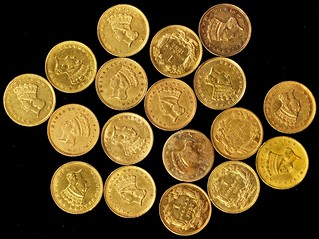 In his book Lost and Found Coin Hoards and Treasures, Q. David Bowers shares a 1996 letter from coin collector Bob Ross, who recalled opening a pool room in Glasgow, Kentucky, in 1954.
In his book Lost and Found Coin Hoards and Treasures, Q. David Bowers shares a 1996 letter from coin collector Bob Ross, who recalled opening a pool room in Glasgow, Kentucky, in 1954. A man walked in and wanted to sell some gold and silver coins to me,
Ross remembered. They all looked like they were just minted, and some were over a hundred years old.
Where had the coins come from? The man I bought these from had been on a construction site when a bulldozer pushed an old shack and the contents into a 20-foot dug water well. He spotted some coins on the path to the well and picked them up. The owner of the property arrived shortly afterward and found enough one-dollar gold coins to make his wife a necklace. He picked up several other gold and silver coins as well. Apparently, the coins were dropping out of an old wood stove that years earlier had been used to heat the now long-abandoned building. It was later learned that any time the old black man, Stephen Landrum (‘Uncle Steve'), who lived there, received money, he would exchange most of the bills for coins. The story was that most of the coins are still down at the bottom of the well. Maybe yes, or maybe no.
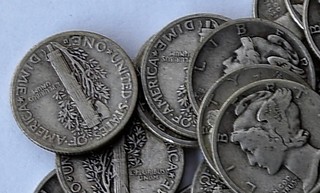 Uncle Steve's preference for keeping gold and silver coins and doing business in cash was confirmed by his attorney, Mr. Smith, writing in the Kentucky State Bar Journal in 1940.
Uncle Steve's preference for keeping gold and silver coins and doing business in cash was confirmed by his attorney, Mr. Smith, writing in the Kentucky State Bar Journal in 1940. One time I helped him in his negotiations to purchase a house in Glasgow for which he was to pay forty-five hundred dollars,
Smith reminisced. The deed was drawn and ready for delivery and it was time for ‘Uncle Steve' to pay. ‘Just wait a little while, and I'll be back.' He was gone some fifteen or twenty minutes, and when he returned he had exactly forty-five hundred dollars in a little split-bark basket with a napkin over the money. There was nothing larger than a ten-dollar bill in the basket and there were many ones and several double hands full of silver.
When Smith drew up Uncle Steve's will a few years before his death, he charged him $25 for the service. Uncle Steve paid him with 250 silver dimes.
30 years after Uncle Steve Landrum passed, a Glasgow businessman bought an 1850 half dollar (like the one pictured here) rumored to come from the old man's hidden stash. (Courtesy of Stack's Bowers Galleries.)
Dennis adds:
"I've been fascinated by the life of Uncle Steve
Landrum since I first read a brief mention of him in Dave Bowers's book. I love the story of how he paused a real-estate transaction and came back 20 minutes later, paying cash with a basket full of money! And he left part of his estate to help kids learn how to read and write --- things he couldn't do, but still he built a fortune. If you believe the online inflation calculators,
his $100,000 in 1923 is equal to about $1.7 million in 2022. The average Americans today has saved just a tiny fraction of that toward retirement—and Stephen Landrum started life as a slave. He was, and is, remarkable."
To read the complete article, see:
From the Colonel's Desk: The marvelous fortune of Glasgow's Uncle Steve
Landrum
(https://news.coinupdate.com/from-the-colonels-desk-the-marvelous-fortune-of-glasgows-uncle-steve-landrum/)
COVERAGE OF THE DANIEL MORGAN GOLD MEDAL
News of the discovery of the unique Daniel Morgan at Cowpens Comitia Americana medal has been hitting the media this week. In an article on the front page of the Spartanburg, SC Herald-Journal, cataloguer John Kraljevich was interviewed about the iconic piece. Here's an excerpt. See the complete article online. -Editor
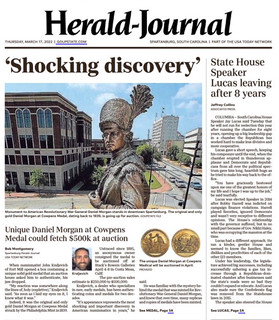 When numismatist John Kraljevich of Fort Mill opened a box containing a unique solid gold medal that an auction house asked him to authenticate, his jaw dropped.
When numismatist John Kraljevich of Fort Mill opened a box containing a unique solid gold medal that an auction house asked him to authenticate, his jaw dropped.
"My reaction was somewhere along the lines of, holy (expletive)," Kraljevich said. "As soon as I laid my eyes on it, I knew what it was."
Indeed, it was the original and only gold Daniel Morgan at Cowpens Medal struck by the Philadelphia Mint in 1839.
Untraced since 1885, an anonymous owner consigned the medal to be auctioned off at Stack's Bowers Galleries April 4-8 in Costa Mesa, Calif.
The pre-auction sales estimate is $250,000 to $500,000.
Kraljevich, a dealer who specializes in rare, early medals, has been authenticating coins and medals for two decades.
"It's appearance represents the most shocking and important discovery in American numismatics in years," he said.
He was familiar with the mystery behind the medal that was minted for Revolutionary War General Daniel Morgan, and knew that over time, many replicas and copies of medals have been minted. A similar medal awarded in 1818 to Gen. William Henry Harrison for leading a decisive U.S. victory in the War of 1812 brought $600,000 at an auction last year, he said.
"This piece (the Morgan medal) is in much better condition," Kraljevich said. "This medal is famous because of the exquisite artistry, its rarity, condition and a great story. If it brought a similar amount ($600,000) I would be very pleased."
In the mid-1970s, for example, newspapers reported that a metal detector from Greer found what he believed was the Morgan medal 15 inches underground. The finder said he sent the medal to the Smithsonian Institute for identification, according to reports.
But Kraljevich said he couldn't find any subsequent records to validate the story.
"In our business, we see local newspapers publish very credulous articles from metal detectors who claim to have found something wonderful," he said. "Typically (the reports) are a red herring and typically never seen again.
"There are a lot of reasons for replicas (of the Morgan medal) to be found here, but not the original. There is no shred of evidence that the original was ever in the state of South Carolina."
A similar medal awarded in 1818 to Gen. William Henry Harrison for leading a decisive U.S. victory in the War of 1812 brought $600,000 at an auction last year, he said.
"This piece (the Morgan medal) is in much better condition," Kraljevich said. "This medal is famous because of the exquisite artistry, its rarity, condition and a great story. If it brought a similar amount ($600,000) I would be very pleased."
As a consultant, Kraljevich also provided the history of the medal to Stack's Bowers Galleries for publication of its Spring 2022 Auction catalog.
To read the complete article, see:
'Shocking discovery:' Daniel Morgan at Cowpens Medal could fetch $500k at April auction
(https://www.goupstate.com/story/news/local/2022/03/16/revolutionary-war-general-daniel-morgan-cowpens-medal-auctioned/9437740002/)
Word of the medal's discovery travelled as far as Russia... -Editor
To read the complete article (in Russian), see:
Найдена исчезнувшая 140 лет назад уникальная медаль за 53 миллиона рублей
(https://lenta.ru/news/2022/03/17/medal/)
ZERO EURO NOTES RAISE FUNDS FOR UKRAINE
Some nicely produced zero-Euro notes are being produced to raise funds for children and families from Ukraine. Here's a Google-translated article by Hans Ludwig Grabowski from Geldscheine Online. -Editor
The chairman of the association "We help children" from Salzgitter, Volker Machura, is overjoyed. Not only was the association able to collect donations of 52,000 euros for children and families from the Ukraine within just one week, now a businessman from Salzgitter, who is well known in the world of numismatics, has started a special campaign for the association.
The company Mietens & Partner, wholesaler for coins and banknotes, has issued a 0-euro peace note "PEACE FOR UKRAINE". In view of the already high demand, the total circulation was increased from 5,000 to 10,000 copies. Of course, like all other 0-euro notes, these are also printed on original banknote paper.
The 0-euro peace note is a novelty among the euro souvenir notes that are already available from many countries, for example for sights, and are equally popular with tourists and collectors. Not only is it supporting a fundraising campaign for the first time, it is also the first 0-euro note that deviates from the usual color scheme and also shows the national colors of Ukraine yellow and blue on the front. That's why the printing costs are 87.5% higher than for normal 0-euro bills.
Anyone who would like to support the association "We help children" eV can do so by purchasing a 0-euro peace coupon "PEACE FOR UKRAINE".
Each ticket costs only 7.50 euros!
Please only order directly through the association!
The proceeds from the donation will go to the following non-profit association for the support of children and families from Ukraine:
We help children eV
Chairman of the Board: Volker Machura
Lange Wanne 87 38259 Salzgitter
Telephone: (05341) 35 921
Mobile: (01522) 1733156
Email:
volker.machura@wirhelfenkindern.eu
Internet:
https://www.wirhelfenkindern.eu/
The association donates around EUR 4.00 (EUR 3.99) for each ticket sold (sales price minus purchase price and VAT). In addition, the company Mietens donates 1 euro per ticket sold to the association. From 7.50 euros, around 5 euros will benefit the campaign. From the remaining 2.50 the production costs and the VAT are to be paid.
Battenberg Gietl Verlag with the magazines "MünzenRevue", "Coins & Collecting" and "Numismatikes Nachrichtenblatt" as well as the blogs www.geldscheine-online.com and www.muenzen-online.com ask for your support. You are not only helping children and families affected by the war, you are also acquiring a very special, memorable piece for your collection.
Thank you very much for your support!
Hans Ludwig Grabowski
To read the complete article, see:
0 euro note: PEACE FOR UKRAINE in favor of "We help children"
(https://www.geldscheine-online.com/post/0-euro-schein-peace-for-ukraine-zugunsten-von-wir-helfen-kindern)

